Energy Harvesting from Fluid Flow Using Piezoelectric Materials: A Review
Abstract
1. Introduction
2. Energy Harvesting from Fluid Flow
2.1. Wind Flow
2.1.1. Windmills and Wind-Turbine-Style Harvesters
2.1.2. Flutter Style Harvesters
2.1.3. Vortex Induces Vibrations
2.2. Galloping
3. Water Flow
4. Piezoelectric Materials in Ocean Wave Harvesting
5. Future Challenges and Recommendations
6. Conclusions
Author Contributions
Funding
Institutional Review Board Statement
Informed Consent Statement
Data Availability Statement
Conflicts of Interest
References
- Yang, Z.; Zhou, S.; Zu, J.; Inman, D. High-Performance Piezoelectric Energy Harvesters and Their Applications. Joule 2018, 2, 642–697. [Google Scholar] [CrossRef]
- Laws, N.D.; Epps, B.P. Hydrokinetic energy conversion: Technology, research, and outlook. Renew. Sustain. Energy Rev. 2016, 57, 1245–1259. [Google Scholar] [CrossRef]
- Zhao, L.-C.; Zou, H.X.; Yan, G.; Liu, F.R.; Tan, T.; Zhang, W.M.; Peng, Z.K.; Meng, G. A water-proof magnetically coupled piezoelectric-electromagnetic hybrid wind energy harvester. Appl. Energy 2019, 239, 735–746. [Google Scholar] [CrossRef]
- Rome, L.C.; Flynn, L.; Goldman, E.M.; Yoo, T.D. Generating Electricity While Walking with Loads. Science 2005, 309, 1725–1728. [Google Scholar] [CrossRef] [PubMed]
- Daqaq, M.F.; Masana, R.; Erturk, A.; Dane Quinn, D. On the Role of Nonlinearities in Vibratory Energy Harvesting: A Critical Review and Discussion. Appl. Mech. Rev. 2014, 66, 040801. [Google Scholar] [CrossRef]
- Yildirim, T.; Ghayesh, M.H.; Li, W.; Alici, G. A review on performance enhancement techniques for ambient vibration energy harvesters. Renew. Sustain. Energy Rev. 2017, 71, 435–449. [Google Scholar] [CrossRef]
- Shaikh, F.K.; Zeadally, S. Energy harvesting in wireless sensor networks: A comprehensive review. Renew. Sustain. Energy Rev. 2016, 55, 1041–1054. [Google Scholar] [CrossRef]
- Seah, W.K.G.; Eu, Z.A.; Tan, H.-P. Wireless sensor networks powered by ambient energy harvesting (WSN-HEAP)—Survey and challenges. In Proceedings of the 2009 1st International Conference on Wireless Communication, Vehicular Technology, Information Theory and Aerospace Electronic Systems Technology, Aalborg, Denmark, 17–20 May 2009; pp. 1–5. [Google Scholar] [CrossRef]
- Verma, G.; Sharma, V.; Pughat, A. Energy harvesting issues in wireless sensor networks. In Energy-Efficient Wireless Sensor Networks; CRC Press: Boca Raton, FL, USA, 2017; pp. 137–163. [Google Scholar] [CrossRef]
- Kouritem, S.A. Array of piezoelectric energy harvesters for broadband natural frequency applications. In Proceedings of the ICSV27, Annual Congress of International Institute of Acoustics and Vibration (IIAV), Prague, Czech Republic, 11–16 July 2021. [Google Scholar]
- Paulo, J.; Gaspar, P.D. Review and future trend of energy harvesting methods for portable medical devices. In Proceedings of the World Congress on Engineering, London, UK, 30 June–2 July 2010; Volume 2, pp. 909–914. [Google Scholar]
- Bowen, C.R.; Taylor, J.; LeBoulbar, E.; Zabek, D.; Chauhan, A.; Vaish, R. Pyroelectric materials and devices for energy harvesting applications. Energy Environ. Sci. 2014, 7, 3836–3856. [Google Scholar] [CrossRef]
- Abdelkefi, A. Aeroelastic energy harvesting: A review. Int. J. Eng. Sci. 2016, 100, 112–135. [Google Scholar] [CrossRef]
- Trolier-McKinstry, S.; Zhang, S.; Bell, A.J.; Tan, X. High-Performance Piezoelectric Crystals, Ceramics, and Films. Annu. Rev. Mater. Res. 2018, 48, 191–217. [Google Scholar] [CrossRef]
- Zhang, S.; Li, F.; Jiang, X.; Kim, J.; Luo, J.; Geng, X. Advantages and challenges of relaxor-PbTiO3 ferroelectric crystals for electroacoustic transducers—A review. Prog. Mater. Sci. 2015, 68, 1–66. [Google Scholar] [CrossRef]
- Brosnan, K.H.; Messing, G.L.; Markley, D.C.; Meyer, R.J. Comparison of the properties of tonpilz transducers fabricated with ⟨001⟩ fiber-textured lead magnesium niobate-lead titanate ceramic and single crystals. J. Acoust. Soc. Am. 2009, 126, 2257–2265. [Google Scholar] [CrossRef]
- Levassort, F.; Thi, M.P.; Marechal, P.; Tran-Huu-Hue, L.-P.; Lethiecq, M. Ultrasonic transducer based on highly textured PMN-PT piezoelectric ceramic. J. Electroceram. 2007, 19, 375–381. [Google Scholar] [CrossRef]
- Levassort, F.; Pham Thi, M.; Hemery, H.; Marechal, P.; Tran-Huu-Hue, L.-P.; Lethiecq, M. Piezoelectric textured ceramics: Effective properties and application to ultrasonic transducers. Ultrasonics 2006, 44, e621–e626. [Google Scholar] [CrossRef]
- Muralt, P. Ferroelectric thin films for micro-sensors and actuators: A review. J. Micromech. Microeng. 2000, 10, 136–146. [Google Scholar] [CrossRef]
- Zhang, H.; Zhou, J.; Shen, J.; Yang, X.; Wu, C.; Han, K.; Zhao, Z.; Chen, W. Enhanced piezoelectric property and promoted depolarization temperature in Fe doped Bi1/2(Na0.8K0.2)1/2TiO3 lead-free ceramics. Ceram. Int. 2017, 43, 16395–16402. [Google Scholar] [CrossRef]
- Dagdeviren, C.; Joe, P.; Tuzman, O.L.; Park, K.I.; Lee, K.J.; Shi, Y.; Huang, Y.; Rogers, J.A. Recent progress in flexible and stretchable piezoelectric devices for mechanical energy harvesting, sensing and actuation. Extrem. Mech. Lett. 2016, 9, 269–281. [Google Scholar] [CrossRef]
- Chen, Y.; Zhang, Y.; Zhang, L.; Ding, F.; Schmidt, O.G. Scalable single crystalline PMN-PT nanobelts sculpted from bulk for energy harvesting. Nano Energy 2017, 31, 239–246. [Google Scholar] [CrossRef]
- Bani-Hani, M.; Almomani, A.; Aljanaideh, K.; Kouritem, S.A. Mechanical Modeling and Numerical Investigation of Earthquake-Induced Structural Vibration Self Powered Sensing Device. IEEE Sens. J. 2022, preprint. [Google Scholar] [CrossRef]
- Yan, X.; Cui, X.; Li, B.; Li, L. Large, Solution-Processable Graphene Quantum Dots as Light Absorbers for Photovoltaics. Nano Lett. 2010, 10, 1869–1873. [Google Scholar] [CrossRef] [PubMed]
- Kouritem, S.A.; Al-Moghazy, M.A.; Noori, M.; Altabey, W.A. Mass tuning technique for a broadband piezoelectric energy harvester array. Mech. Syst. Signal Process. 2022, 181, 109500. [Google Scholar] [CrossRef]
- Mohamed, K.T.; El-Gamal, H.A.; Kouritem, S.A. An Experimental Validation of a New Shape Optimization Technique for Piezoelectric Harvesting Cantilever Beams. Alex. Eng. J. 2021, 60, 1751–1766. [Google Scholar] [CrossRef]
- Husain, A.A.F.; Hasan, W.Z.W.; Shafie, S.; Hamidon, M.N.; Pandey, S.S. A review of transparent solar photovoltaic technologies. Renew. Sustain. Energy Rev. 2018, 94, 779–791. [Google Scholar] [CrossRef]
- Seyedmahmoudian, M.; Kok Soon, T.; Jamei, E.; Thirunavukkarasu, G.S.; Horan, B.; Mekhilef, S.; Stojcevski, A. Maximum Power Point Tracking for Photovoltaic Systems under Partial Shading Conditions Using Bat Algorithm. Sustainability 2018, 10, 1347. [Google Scholar] [CrossRef]
- Tiwari, G.N.; Mishra, R.K.; Solanki, S.C. Photovoltaic modules and their applications: A review on thermal modelling. Appl. Energy 2011, 88, 2287–2304. [Google Scholar] [CrossRef]
- Frischmann, P.D.; Mahata, K.; Würthner, F. Powering the future of molecular artificial photosynthesis with light-harvesting metallosupramolecular dye assemblies. Chem. Soc. Rev. 2013, 42, 1847–1870. [Google Scholar] [CrossRef]
- Tian, R.; Wan, C.; Hayashi, N.; Aoai, T.; Koumoto, K. Wearable and flexible thermoelectrics for energy harvesting. MRS Bull. 2018, 43, 193–198. [Google Scholar] [CrossRef]
- Salem, M.S.; Ahmed, S.; Shaker, A.; Alshammari, M.T.; Al-Dhlan, K.A.; Alanazi, A.; Saeed, A.; Abouelatta, M. Bandwidth Broadening of Piezoelectric Energy Harvesters Using Arrays of a Proposed Piezoelectric Cantilever Structure. Micromachines 2021, 12, 973. [Google Scholar] [CrossRef]
- Blackburn, J.L.; Ferguson, A.J.; Cho, C.; Grunlan, J.C. Carbon-Nanotube-Based Thermoelectric Materials and Devices. Adv. Mater. 2018, 30, 1704386. [Google Scholar] [CrossRef]
- Hunter, S.R.; Lavrik, N.V.; Mostafa, S.; Rajic, S.; Datskos, P.G. Review of pyroelectric thermal energy harvesting and new MEMs-based resonant energy conversion techniques. In Energy Harvesting and Storage: Materials, Devices, and Applications III; SPIE: Baltimore, MD, USA, 2012; Volume 8377, pp. 77–90. [Google Scholar] [CrossRef]
- Cuadras, A.; Gasulla, M.; Ferrari, V. Thermal energy harvesting through pyroelectricity. Sens. Actuators A Phys. 2010, 158, 132–139. [Google Scholar] [CrossRef]
- Mondal, S.; Chowdhury, A.R.; Kanu, A.; Bhattacharjee, S. Piezoelectric Energy Harvesting by Utilizing Angular Speed Variation in High-Speed Rotating Beams by Utilizing Angular Speed Variation in High-Speed Rotating Beams. Bachelor’s Thesis, National Institute of Technology, Durgapur, India, May 2022. [Google Scholar] [CrossRef]
- Narita, F.; Fox, M. A Review on Piezoelectric, Magnetostrictive, and Magnetoelectric Materials and Device Technologies for Energy Harvesting Applications. Adv. Eng. Mater. 2018, 20, 1700743. [Google Scholar] [CrossRef]
- Wang, H.; Jasim, A.; Chen, X. Energy harvesting technologies in roadway and bridge for different applications—A comprehensive review. Appl. Energy 2018, 212, 1083–1094. [Google Scholar] [CrossRef]
- Stephen, N.G. On energy harvesting from ambient vibration. J. Sound Vib. 2006, 293, 409–425. [Google Scholar] [CrossRef]
- Saadon, S.; Sidek, O. A review of vibration-based MEMS piezoelectric energy harvesters. Energy Convers. Manag. 2011, 52, 500–504. [Google Scholar] [CrossRef]
- Harne, R.L.; Wang, K.W. A review of the recent research on vibration energy harvesting via bistable systems. Smart Mater. Struct. 2013, 22, 23001. [Google Scholar] [CrossRef]
- Sriphan, S.; Vittayakorn, N. Hybrid piezoelectric-triboelectric nanogenerators for flexible electronics: Recent advances and perspectives. J. Sci. Adv. Mater. Devices 2022, 7, 100461. [Google Scholar] [CrossRef]
- Shi, Q.; Sun, Z.; Zhang, Z.; Le, C. Triboelectric Nanogenerators and Hybridized Systems for Enabling Next-Generation IoT Applications. Research 2021, 2021, 6849171. [Google Scholar] [CrossRef]
- Huang, C.; Chen, G.; Nashalian, A.; Chen, J. Advances in self-powered chemical sensing via a triboelectric nanogenerator. Nanoscale 2021, 13, 2065–2081. [Google Scholar] [CrossRef]
- Dani, S.; Tripathy, A.; Alluri, N.; Balasubramaniam, S.; Ramadoss, A. A Critical Review: Impact of Electrical Poling on Longitudinal Piezoelectric Strain Coefficient. Mater. Adv. 2022, in press. [CrossRef]
- Liu, H.; Zhong, J.; Lee, C.; Lee, S.; Lin, L. A comprehensive review on piezoelectric energy harvesting technology: Materials, mechanisms, and applications. Appl. Phys. Rev. 2018, 5, 041306. [Google Scholar] [CrossRef]
- Lee, B.; Lin, S.; Wu, W.; Wang, X.; Chang, P.; Lee, C. Piezoelectric MEMS generators fabricated with an aerosol deposition PZT thin film. J. Micromech. Microeng. 2009, 19, 065014. [Google Scholar] [CrossRef]
- Kim, S.; Park, H.; Kim, S.; Wikle, H.; Park, J.; Kim, D. Comparison of MEMS PZT Cantilevers Based on d31 and d33 Modes for Vibration Energy Harvesting. J. Microelectromech. Syst. 2013, 22, 26–33. [Google Scholar] [CrossRef]
- Wu, Y.; Ma, Y.; Zheng, H.; Ramakrishna, S. Piezoelectric materials for flexible and wearable electronics: A review. Mater. Des. 2021, 211, 110164. [Google Scholar] [CrossRef]
- Wang, C.; Yu, Y.; Yuan, Y.; Ren, C.; Liao, Q.; Wang, J.; Chai, Z.; Li, Q.; Li, Z. Heartbeat-Sensing Mechanoluminescent Device Based on a Quantitative Relationship between Pressure and Emissive Intensity. Matter 2020, 2, 181–193. [Google Scholar] [CrossRef]
- Aliqué, M.; Simão, C.; Murillo, G.; Moya, A. Fully-Printed Piezoelectric Devices for Flexible Electronics Applications. Adv. Mater. Technol. 2021, 6, 2001020. [Google Scholar] [CrossRef]
- Kim, H.; Lee, D.W.; Kim, D.H.; Kong, D.S.; Choi, J.; Lee, M.; Murillo, G.; Jung, J.H. Dominant Role of Young’s Modulus for Electric Power Generation in PVDF–BaTiO3 Composite-Based Piezoelectric Nanogenerator. Nanomaterials 2018, 8, 777. [Google Scholar] [CrossRef]
- Lee, H.; Zhang, S.; Bar-Cohen, Y.; Sherrit, S. High Temperature, High Power Piezoelectric Composite Transducers. Sensors 2014, 14, 14526–14552. [Google Scholar] [CrossRef]
- Smith, W.; Auld, B. Modeling 1-3 composite piezoelectrics: Thickness-mode oscillations. IEEE Trans. Ultrason. Ferroelectr. Freq. Control 1991, 38, 40–47. [Google Scholar] [CrossRef]
- Li, W.; Chen, X. Compensation of hysteresis in piezoelectric actuators without dynamics modeling. Sens. Actuators A Phys. 2013, 199, 89–97. [Google Scholar] [CrossRef]
- Li, W.; Chen, X.; Li, Z. Inverse compensation for hysteresis in piezoelectric actuator using an asymmetric rate-dependent model. Rev. Sci. Instrum. 2013, 84, 115003. [Google Scholar] [CrossRef]
- Sezer, N.; Koç, M. A comprehensive review on the state-of-the-art of piezoelectric energy harvesting. Nano Energy 2021, 80, 105567. [Google Scholar] [CrossRef]
- Siang, J.; Lim, M.; Salman Leong, M. Review of vibration-based energy harvesting technology: Mechanism and architectural approach. Int. J. Energy Res. 2018, 42, 1866–1893. [Google Scholar] [CrossRef]
- Ansari, M.; Somdee, P. Piezoelectric Polymeric Foams as Flexible Energy Harvesters: A Review. Adv. Energy Sustain. Res. 2022, 3, 2200063. [Google Scholar] [CrossRef]
- Shan, X.; Song, R.; Liu, B.; Xie, T. Novel energy harvesting: A macro fiber composite piezoelectric energy harvester in the water vortex. Ceram. Int. 2015, 41 (Suppl. S1), S763–S767. [Google Scholar] [CrossRef]
- Safaei, M.; Sodano, H.A.; Anton, S.R. A review of energy harvesting using piezoelectric materials: State-of-the-art a decade later (2008–2018). Smart Mater. Struct. 2019, 28, 113001. [Google Scholar] [CrossRef]
- Abrol, S.; Chhabra, D. Harvesting piezoelectricity using different structures by utilizing fluid flow interactions. Int. J. R D Eng. Sci. Manag. 2017, 5, 24–36. [Google Scholar]
- Chen, Z.; Guo, B.; Yang, Y.; Cheng, C. Metamaterials-based enhanced energy harvesting: A review. Phys. B Condens. Matter 2014, 438, 1–8. [Google Scholar] [CrossRef]
- Anton, S.R.; Sodano, H.A. A review of power harvesting using piezoelectric materials (2003–2006). Smart Mater. Struct. 2007, 16, R1–R21. [Google Scholar] [CrossRef]
- Tien, C.M.T.; Goo, N.S. Use of a piezo-composite generating element for harvesting wind energy in an urban region. Aircr. Eng. Aerosp. Technol. 2010, 82, 376–381. [Google Scholar] [CrossRef]
- Zeng, P.; Khaligh, A. A Permanent-Magnet Linear Motion Driven Kinetic Energy Harvester. IEEE Trans. Ind. Electron. 2013, 60, 5737–5746. [Google Scholar] [CrossRef]
- Tang, Q.; Li, X. Two-Stage Wideband Energy Harvester Driven by Multimode Coupled Vibration. IEEE ASME Trans. Mechatron. 2015, 20, 115–121. [Google Scholar] [CrossRef]
- Sankman, J.; Ma, D. A 12-μW to 1.1-mW AIM Piezoelectric Energy Harvester for Time-Varying Vibrations with 450-nA. IEEE Trans. Power Electron. 2015, 30, 632–643. [Google Scholar] [CrossRef]
- Dallago, E.; Barnabei, A.L.; Liberale, A.; Malcovati, P.; Venchi, G. An Interface Circuit for Low-Voltage Low-Current Energy Harvesting Systems. IEEE Trans. Power Electron. 2015, 30, 1411–1420. [Google Scholar] [CrossRef]
- Ziegler, S.; Woodward, R.C.; Iu, H.H.-C.; Borle, L.J. Current Sensing Techniques: A Review. IEEE Sens. J. 2009, 9, 354–376. [Google Scholar] [CrossRef]
- Tan, Y.K.; Panda, S.K. Self-Autonomous Wireless Sensor Nodes with Wind Energy Harvesting for Remote Sensing of Wind-Driven Wildfire Spread. IEEE Trans. Instrum. Meas. 2011, 60, 1367–1377. [Google Scholar] [CrossRef]
- Zhao, L.; Yang, Y. Toward Small-Scale Wind Energy Harvesting: Design, Enhancement, Performance Comparison, and Applicability. Shock Vib. 2017, 2017, 3585972. [Google Scholar] [CrossRef]
- Ovejas, V.J.; Cuadras, A. Multimodal piezoelectric wind energy harvesters. Smart Mater. Struct. 2011, 20, 85030. [Google Scholar] [CrossRef]
- Yadav, N.; Baredar, P. A review on piezoelectric energy harvesting system using vortex induced vibration. AIP Conf. Proc. 2018, 2039, 020054. [Google Scholar] [CrossRef]
- Yang, Y.; Shen, Q.; Jin, J.; Wang, Y.; Qian, W.; Yuan, D. Rotational piezoelectric wind energy harvesting using impact-induced resonance. Appl. Phys. Lett. 2014, 105, 53901. [Google Scholar] [CrossRef]
- Rancourt, D.; Tabesh, A. Evaluation of centimeter-scale micro windmills: Aerodynamics and electromagnetic power generation. Dig. Power MEMS 2017, 2007, 93–96. [Google Scholar]
- Bansal, A.; Howey, D.A.; Holmes, A.S. CM-scale air turbine and generator for energy harvesting from low-speed flows. In Proceedings of the TRANSDUCERS 2009—2009 International Solid-State Sensors, Actuators and Microsystems Conference, Denver, CO, USA, 21–25 June 2009; pp. 529–532. [Google Scholar] [CrossRef]
- Howey, D.A.; Bansal, A.; Holmes, A.S. Design and performance of a centimetre-scale shrouded wind turbine for energy harvesting. Smart Mater. Struct. 2011, 20, 85021. [Google Scholar] [CrossRef]
- Priya, S.; Chen, C.-T.; Fye, D.; Zahnd, J. Piezoelectric Windmill: A Novel Solution to Remote Sensing. Jpn. J. Appl. Phys. 2004, 44, L104–L107. [Google Scholar] [CrossRef]
- Karami, M.A.; Farmer, J.R.; Inman, D.J. Parametrically excited nonlinear piezoelectric compact wind turbine. Renew. Energy 2013, 50, 977–987. [Google Scholar] [CrossRef]
- Bressers, S.; Avirovik, D.; Lallart, M.; Inman, D.J.; Priya, S. Contact-less Wind Turbine Utilizing Piezoelectric Bimorphs with Magnetic Actuation. Struct. Dyn. 2011, 3, 233–243. [Google Scholar]
- Chen, C.-T.; Islam, R.A.; Priya, S. Electric energy generator. IEEE Trans. Ultrason. Ferroelectr. Freq. Control 2006, 53, 656–661. [Google Scholar] [CrossRef] [PubMed]
- Liya, Z. Small-Scale Wind Energy Harvesting Using Piezoelectric Materials. Nanyan Techonol. Univ. 2021, 2015. [Google Scholar] [CrossRef]
- Allen, J.J.; Smits, A.J. Energy Harvesting EEL. J. Fluids Struct. 2001, 15, 629–640. [Google Scholar] [CrossRef]
- Gao, X.; Shih, W.-H.; Shih, W.Y. Flow Energy Harvesting Using Piezoelectric Cantilevers with Cylindrical Extension. IEEE Trans. Ind. Electron. 2013, 60, 1116–1118. [Google Scholar] [CrossRef]
- McKinney, W.; DeLaurier, J. Wingmill: An Oscillating-Wing Windmill. J. Energy 1981, 5, 109–115. [Google Scholar] [CrossRef]
- Bryant, M.; Garcia, E. Modeling and Testing of a Novel Aeroelastic Flutter Energy Harvester. J. Vib. Acoust. 2011, 133, 011010. [Google Scholar] [CrossRef]
- Bryant, M.; Garcia, E. Energy harvesting: A key to wireless sensor nodes. In Proceedings of the Second International Conference on Smart Materials and Nanotechnology in Engineering, Weihai, China, 8–11 July 2009; Volume 7493, pp. 523–530. [Google Scholar] [CrossRef]
- Bryant, M.; Tse, R.; Garcia, E. Investigation of Host Structure Compliance in Aeroelastic Energy Harvesting. Smart Mater. Adapt. Struct. Intell. Syst. 2012, 2, 769–775. [Google Scholar] [CrossRef]
- Bryant, M.; Pizzonia, M.; Mehallow, M.; Garcia, E. Energy harvesting for self-powered aerostructure actuation. In Proceedings of the Active and Passive Smart Structures and Integrated Systems, San Diego, CA, USA, 10–13 March 2014; Volume 9057, pp. 121–129. [Google Scholar] [CrossRef]
- Bryant, M.; Schlichting, A.D.; Garcia, E. Toward efficient aeroelastic energy harvesting: Device performance comparisons and improvements through synchronized switching. In Proceedings of the Active and Passive Smart Structures and Integrated Systems, San Diego, CA, USA, 10–14 March 2013; Volume 8688, pp. 33–42. [Google Scholar] [CrossRef]
- Bryant, M.; Wolff, E.; Garcia, E. Parametric design study of an aeroelastic flutter energy harvester. In Proceedings of the SPIE Smart Structures and Materials + Nondestructive Evaluation and Health Monitoring, San Diego, CA, USA, 8–12 March 2011; Volume 7977. [Google Scholar] [CrossRef]
- Erturk, A.; Vieira, W.G.R.; De Marqui, C.; Inman, D.J. On the energy harvesting potential of piezoaeroelastic systems. Appl. Phys. Lett. 2010, 96, 184103. [Google Scholar] [CrossRef]
- Erturk, A.; Bilgen, O.; Fontenille, M.; Inman, D.J. Piezoelectric energy harvesting from macro-fiber composites with an application to morphing-wing aircrafts. In Proceedings of the 19th International Conference on Adaptive Structures and Technologies, Ascona, Switzerland, 6–9 October 2008; pp. 339–359. [Google Scholar]
- Boragno, C.; Festa, R.; Mazzino, A. Elastically bounded flapping wing for energy harvesting. Appl. Phys. Lett. 2012, 100, 253906. [Google Scholar] [CrossRef]
- Sousa, V.C.; Anicézio, M.D.M.; De Marqui, C., Jr.; Erturk, A. Enhanced aeroelastic energy harvesting by exploiting combined nonlinearities: Theory and experiment. Smart Mater. Struct. 2011, 20, 94007. [Google Scholar] [CrossRef]
- Li, S.; Lipson, H. Vertical-Stalk Flapping-Leaf Generator for Wind Energy Harvesting. Smart Mater. Adapt. Struct. Intell. Syst. 2009, 21, 611–619. [Google Scholar] [CrossRef]
- Wu, L.; Jin, Z.; Liu, Y.; Ning, H.; Liu, X.; Hu, N. Recent advances in the preparation of PVDF-based piezoelectric materials. Nanotechnol. Rev. 2022, 11, 1386–1407. [Google Scholar] [CrossRef]
- Deivasigamani, A.; McCarthy, J.M.; John, S.; Watkins, S.; Trivailo, P.; Coman, F. Piezoelectric energy harvesting from wind using coupled bending-torsional vibrations. Mod. Appl. Sci. 2014, 8, 106–126. [Google Scholar] [CrossRef]
- De Marqui Junior, C.; Erturk, A.; Inman, D.J. An electromechanical finite element model for piezoelectric energy harvester plates. J. Sound Vib. 2009, 327, 9–25. [Google Scholar] [CrossRef]
- Hobeck, J.D.; Geslain, D.; Inman, D.J. The dual cantilever flutter phenomenon: A novel energy harvesting method. In Proceedings of the SPIE Smart Structures and Materials + Nondestructive Evaluation and Health Monitoring, San Diego, CA, USA, 9–13 March 2014; Volume 9061. [Google Scholar] [CrossRef]
- Naudascher, E.; Rockwell, D. Oscillator-Model Approach to Theidentification and Assessment Offlow-Induced Vibrations in a System. J. Hydraul. Res. 1980, 18, 59–82. [Google Scholar] [CrossRef]
- Argentina, M.; Mahadevan, L. Fluid-flow-induced flutter of a flag. Proc. Natl. Acad. Sci. USA 2005, 102, 1829–1834. [Google Scholar] [CrossRef] [PubMed]
- McCarthy, J.M.; Watkins, S.; Deivasigamani, A.; John, S.J. Fluttering energy harvesters in the wind: A review. J. Sound Vib. 2016, 361, 355–377. [Google Scholar] [CrossRef]
- Yamaguchi, N.; Yokota, K.; Tsujimoto, Y. Flutter Limits and Behaviors of a Flexible Thin Sheet in High-Speed Flow—I: Analytical Method for Prediction of the Sheet Behavior. J. Fluids Eng. 1999, 122, 65–73. [Google Scholar] [CrossRef]
- Kashyap, A.S.; Vidya Shankar, K.V.; Vignesh, S. Renewable energy from vortex induced vibrations in a slow moving fluid. In Proceedings of the 2010 International Conference on Environmental Engineering and Applications, Singapore, 10–12 September 2010; pp. 263–266. [Google Scholar] [CrossRef]
- Akaydin, H.D.; Elvin, N.; Andreopoulos, Y. The performance of a self-excited fluidic energy harvester. Smart Mater. Struct. 2012, 21, 25007. [Google Scholar] [CrossRef]
- Weinstein, L.A.; Cacan, M.R.; So, P.M.; Wright, P.K. Vortex shedding induced energy harvesting from piezoelectric materials in heating, ventilation and air conditioning flows. Smart Mater. Struct. 2012, 21, 45003. [Google Scholar] [CrossRef]
- Goushcha, O.; Elvin, N.; Andreopoulos, Y. Interactions of vortices with a flexible beam with applications in fluidic energy harvesting. Appl. Phys. Lett. 2014, 104, 21919. [Google Scholar] [CrossRef]
- Xu-Xu, J.; Barrero-Gil, A.; Velazquez, A. Dual mass system for enhancing energy extraction from Vortex-Induced Vibrations of a circular cylinder. Int. J. Mar. Energy 2016, 16, 250–261. [Google Scholar] [CrossRef]
- Wang, D.-A.; Ko, H.-H. Piezoelectric energy harvesting from flow-induced vibration. J. Micromech. Microeng. 2010, 20, 25019. [Google Scholar] [CrossRef]
- Wang, D.-A.; Chang, K.-H. Electromagnetic energy harvesting from flow induced vibration. Microelectron. J. 2010, 41, 356–364. [Google Scholar] [CrossRef]
- Williamson, J.D.B.S.J.; Stark, B.H. Low Head Pico Hydro Turbine Selection using a Multi-Criteria Analysis. In Proceedings of the World Renewable Energy Congress, Linköping, Sweden, 8–13 May 2011; Volume 6, pp. 1337–1385. Available online: https://ep.liu.se/ecp/057/vol6/ecp057vol6.pdf#page=5 (accessed on 11 August 2022).
- Tam Nguyen, H.-D.; Pham, H.-T.; Wang, D.-A. A miniature pneumatic energy generator using Kármán vortex street. J. Wind Eng. Ind. Aerodyn. 2013, 116, 40–48. [Google Scholar] [CrossRef]
- Wang, J.; Ran, J.; Zhang, Z. Energy Harvester Based on the Synchronization Phenomenon of a Circular Cylinder. Math. Probl. Eng. 2014, 2014, 567357. [Google Scholar] [CrossRef]
- Petrini, F.; Gkoumas, K. Piezoelectric energy harvesting from vortex shedding and galloping induced vibrations inside HVAC ducts. Energy Build. 2018, 158, 371–383. [Google Scholar] [CrossRef]
- Barrero-Gil, A.; Alonso, G.; Sanz-Andres, A. Energy harvesting from transverse galloping. J. Sound Vib. 2010, 329, 2873–2883. [Google Scholar] [CrossRef]
- Sorribes-Palmer, F.; Sanz-Andres, A. Optimization of energy extraction in transverse galloping. J. Fluids Struct. 2013, 43, 124–144. [Google Scholar] [CrossRef]
- Sirohi, J.; Mahadik, R. Piezoelectric wind energy harvester for low-power sensors. J. Intell. Mater. Syst. Struct. 2011, 22, 2215–2228. [Google Scholar] [CrossRef]
- Sirohi, J.; Mahadik, R. Harvesting Wind Energy Using a Galloping Piezoelectric Beam. J. Vib. Acoust. 2011, 134, 011009. [Google Scholar] [CrossRef]
- Abdelkefi, A.; Hajj, M.R.; Nayfeh, A.H. Power harvesting from transverse galloping of square cylinder. Nonlinear Dyn. 2012, 70, 1355–1363. [Google Scholar] [CrossRef]
- Abdelkefi, A.; Yan, Z.; Hajj, M.R. Performance analysis of galloping-based piezoaeroelastic energy harvesters with different cross-section geometries. J. Intell. Mater. Syst. Struct. 2013, 25, 246–256. [Google Scholar] [CrossRef]
- Yang, Y.; Zhao, L.; Tang, L. Comparative study of tip cross-sections for efficient galloping energy harvesting. Appl. Phys. Lett. 2013, 102, 64105. [Google Scholar] [CrossRef]
- Daqaq, M.F. Characterizing the response of galloping energy harvesters using actual wind statistics. J. Sound Vib. 2015, 357, 365–376. [Google Scholar] [CrossRef]
- Bibo, A.; Daqaq, M.F. An analytical framework for the design and comparative analysis of galloping energy harvesters under quasi-steady aerodynamics. Smart Mater. Struct. 2015, 24, 94006. [Google Scholar] [CrossRef]
- Bibo, A.; Daqaq, M.F. On the optimal performance and universal design curves of galloping energy harvesters. Appl. Phys. Lett. 2014, 104, 23901. [Google Scholar] [CrossRef]
- Vicente-Ludlam, D.; Barrero-Gil, A.; Velazquez, A. Enhanced mechanical energy extraction from transverse galloping using a dual mass system. J. Sound Vib. 2015, 339, 290–303. [Google Scholar] [CrossRef]
- Pellegrini, S.P.; Tolou, N.; Schenk, M.; Herder, J.L. Bistable vibration energy harvesters: A review. J. Intell. Mater. Syst. Struct. 2013, 24, 1303–1312. [Google Scholar] [CrossRef]
- Tang, L.; Yang, Y.; Soh, C.K. Toward broadband vibration-based energy harvesting. J. Intell. Mater. Syst. Struct. 2010, 21, 1867–1897. [Google Scholar] [CrossRef]
- Zhao, L.; Tang, L.; Yang, Y. Small Wind Energy Harvesting from Galloping Using Piezoelectric Materials. Smart Mater. Adapt. Struct. Intell. Syst. 2012, 2, 919–927. [Google Scholar] [CrossRef]
- Erturk, A. Electromechanical Modeling of Piezoelectric Energy Harvesters. Ph.D. Dissertation, Virginia Polytechnic Institute and State University, Blacksburg, VA, USA, 2009. [Google Scholar]
- Stanton, S.C.; Erturk, A.; Mann, B.P.; Inman, D.J. Nonlinear piezoelectricity in electroelastic energy harvesters: Modeling and experimental identification. J. Appl. Phys. 2010, 108, 074903. [Google Scholar] [CrossRef]
- Renno, J.M.; Daqaq, M.F.; Inman, D.J. On the optimal energy harvesting from a vibration source. J. Sound Vib. 2009, 320, 386–405. [Google Scholar] [CrossRef]
- Hamlehdar, M.; Kasaeian, A.; Safaei, M.R. Energy Harvesting from Fluid Flow Using Piezoelectrics: A Critical Review. Renew. Energy 2019, 143, 1826–1838. [Google Scholar] [CrossRef]
- Abdelkefi, A.; Najar, F.; Nayfeh, A.H.; Ben Ayed, S. An energy harvester using piezoelectric cantilever beams undergoing coupled bending-torsion vibrations. Smart Mater. Struct. 2011, 20, 115007. [Google Scholar] [CrossRef]
- Myers, R.; Vickers, M.; Kim, H.; Priya, S. Small scale windmill. Appl. Phys. Lett. 2007, 90, 54106. [Google Scholar] [CrossRef]
- Rezaei-Hosseinabadi, N.; Tabesh, A.; Dehghani, R.; Aghili, A. An Efficient Piezoelectric Windmill Topology for Energy Harvesting from Low-Speed Air Flows. IEEE Trans. Ind. Electron. 2015, 62, 3576–3583. [Google Scholar] [CrossRef]
- Stamatellou, A.-M.; Kalfas, A.I. Experimental investigation of energy harvesting from swirling flows using a piezoelectric film transducer. Energy Convers. Manag. 2018, 171, 1405–1415. [Google Scholar] [CrossRef]
- Hobeck, J.D.; Inman, D.J. Artificial piezoelectric grass for energy harvesting from turbulence-induced vibration. Smart Mater. Struct. 2012, 21, 105024. [Google Scholar] [CrossRef]
- Orrego, S.; Shoele, K.; Ruas, A.; Doran, K.; Caggiano, B.; Mittal, R.; Kang, S.H. Harvesting ambient wind energy with an inverted piezoelectric flag. Appl. Energy 2017, 194, 212–222. [Google Scholar] [CrossRef]
- Jun Li, D.; Hong, S.; Gu, S.; Choi, Y.; Nakhmanson, S.; Heinonen, O.; Karpeev, D.; No, K. Polymer piezoelectric energy harvesters for low wind speed. Appl. Phys. Lett. 2014, 104, 12902. [Google Scholar] [CrossRef]
- Priya, S. Modeling of electric energy harvesting using piezoelectric windmill. Appl. Phys. Lett. 2005, 87, 184101. [Google Scholar] [CrossRef]
- Wang, K.X.; Bu, L.; Chen, J.M.; Song, L. Frequency-tunable airflow energy harvester using variable aperture helmholtz resonator and piezoelectric cantilever. In Proceedings of the 2015 Transducers—2015 18th International Conference on Solid-State Sensors, Actuators and Microsystems (TRANSDUCERS), Anchorage, AK, USA, 21–25 June 2015; pp. 1945–1948. [Google Scholar] [CrossRef]
- He, X.; Shang, Z.; Cheng, Y.; Zhu, Y. A micromachined low-frequency piezoelectric harvester for vibration and wind energy scavenging. J. Micromech. Microeng. 2013, 23, 125009. [Google Scholar] [CrossRef]
- Jung, H.J.; Song, Y.; Hong, S.K.; Yang, C.H.; Hwang, S.J.; Jeong, S.Y.; Sung, T.H. Design and optimization of piezoelectric impact-based micro wind energy harvester for wireless sensor network. Sens. Actuators A Phys. 2015, 222, 314–321. [Google Scholar] [CrossRef]
- Matova, S.P.; Elfrink, R.; Vullers, R.J.M.; van Schaijk, R. Harvesting energy from airflow with a michromachined piezoelectric harvester inside a Helmholtz resonator. J. Micromech. Microeng. 2011, 21, 104001. [Google Scholar] [CrossRef]
- Dai, H.L.; Abdelkefi, A.; Yang, Y.; Wang, L. Orientation of bluff body for designing efficient energy harvesters from vortex-induced vibrations. Appl. Phys. Lett. 2016, 108, 53902. [Google Scholar] [CrossRef]
- Wen, Q.; Schulze, R.; Billep, D.; Otto, T.; Gessner, T. Modeling and optimization of a vortex induced vibration fluid kinetic energy harvester. Procedia Eng. 2014, 87, 779–782. [Google Scholar] [CrossRef]
- Xie, J.; Yang, J.; Hu, H.; Hu, Y.; Chen, X. A piezoelectric energy harvester based on flow-induced flexural vibration of a circular cylinder. J. Intell. Mater. Syst. Struct. 2012, 23, 135–139. [Google Scholar] [CrossRef]
- Hobbs, W.B.; Hu, D.L. Tree-inspired piezoelectric energy harvesting. J. Fluids Struct. 2012, 28, 103–114. [Google Scholar] [CrossRef]
- Dai, H.L.; Abdelkefi, A.; Wang, L. Theoretical modeling and nonlinear analysis of piezoelectric energy harvesting from vortex-induced vibrations. J. Intell. Mater. Syst. Struct. 2014, 25, 1861–1874. [Google Scholar] [CrossRef]
- Dunnmon, J.A.; Stanton, S.C.; Mann, B.P.; Dowell, E.H. Power extraction from aeroelastic limit cycle oscillations. J. Fluids Struct. 2011, 27, 1182–1198. [Google Scholar] [CrossRef]
- Li, S.; Yuan, J.; Lipson, H. Ambient wind energy harvesting using cross-flow fluttering. J. Appl. Phys. 2011, 109, 2–5. [Google Scholar] [CrossRef]
- Hobeck, J.D.; Inman, D.J. A distributed parameter electromechanical and statistical model for energy harvesting from turbulence-induced vibration. Smart Mater. Struct. 2014, 23, 115003. [Google Scholar] [CrossRef]
- Alben, S.; Shelley, M.J. Flapping States of a Flag in an Inviscid Fluid: Bistability and the Transition to Chaos. Phys. Rev. Lett. 2008, 100, 74301. [Google Scholar] [CrossRef]
- Akaydın, H.D.; Elvin, N.; Andreopoulos, Y. Wake of a cylinder: A paradigm for energy harvesting with piezoelectric materials. Exp. Fluids 2010, 49, 291–304. [Google Scholar] [CrossRef]
- Goushcha, O.; Akaydin, H.D.; Elvin, N.; Andreopoulos, Y. Energy harvesting prospects in turbulent boundary layers by using piezoelectric transduction. J. Fluids Struct. 2015, 54, 823–847. [Google Scholar] [CrossRef]
- Michelin, S.; Doaré, O. Energy harvesting efficiency of piezoelectric flags in axial flows. J. Fluid Mech. 2013, 714, 489–504. [Google Scholar] [CrossRef]
- Kwon, S.-D. A T-shaped piezoelectric cantilever for fluid energy harvesting. Appl. Phys. Lett. 2010, 97, 164102. [Google Scholar] [CrossRef]
- Bibo, A.; Daqaq, M.F. Energy harvesting under combined aerodynamic and base excitations. J. Sound Vib. 2013, 332, 5086–5102. [Google Scholar] [CrossRef]
- Bibo, A.; Daqaq, M.F. Investigation of concurrent energy harvesting from ambient vibrations and wind using a single piezoelectric generator. Appl. Phys. Lett. 2013, 102, 243904. [Google Scholar] [CrossRef]
- Dowell, E.; Edwards, J.; Strganac, T. Nonlinear Aeroelasticity. J. Aircr. 2003, 40, 857–874. [Google Scholar] [CrossRef]
- Abdelkefi, A.; Hajj, M.R.; Nayfeh, A.H. Phenomena and modeling of piezoelectric energy harvesting from freely oscillating cylinders. Nonlinear Dyn. 2012, 70, 1377–1388. [Google Scholar] [CrossRef]
- Yin, J.; Li, X.; Yu, J.; Zhang, Z.; Zhou, J.; Guo, W. Generating electricity by moving a droplet of ionic liquid along graphene. Nat. Nanotechnol. 2014, 9, 378–383. [Google Scholar] [CrossRef] [PubMed]
- Azevedo, J.; Lopes, J. Energy harvesting from hydroelectric systems for remote sensors. AIMS Energy 2016, 4, 876–893. [Google Scholar] [CrossRef][Green Version]
- Laser, D.J.; Santiago, J.G. A review of micropumps. J. Micromech. Microeng. 2004, 14, R35–R64. [Google Scholar] [CrossRef]
- Hou, Y.; He, L.; Hu, D.; Zhang, L.; Yu, B.; Cheng, G. Recent trends in structures and applications of valveless piezoelectric pump—A review. J. Micromech. Microeng. 2022, 32, 053002. [Google Scholar] [CrossRef]
- Taylor, G.W.; Burns, J.R.; Kammann, S.A.; Powers, W.B.; Welsh, T.R. The Energy Harvesting EEL: A small subsurface ocean/river power generator. IEEE J. Ocean. Eng. 2001, 26, 539–547. [Google Scholar] [CrossRef]
- Pobering, S.; Schwesinger, N. A Novel Hydropower Harvesting Device. In Proceedings of the 2004 International Conference on MEMS, NANO and Smart Systems (ICMENS’04), Banff, AB, Canada, 25–27 August 2004; pp. 480–485. [Google Scholar] [CrossRef]
- Pobering, S.; Ebermeyer, S.; Schwesinger, N. Generation of electrical energy using short piezoelectric cantilevers in flowing media. In Proceedings of the SPIE Smart Structures and Materials + Nondestructive Evaluation and Health Monitoring, San Diego, CA, USA, 8 March 2009; Volume 7288. [Google Scholar] [CrossRef]
- Song, R.; Shan, X.; Lv, F.; Li, J.; Xie, T. A Novel Piezoelectric Energy Harvester Using the Macro Fiber Composite Cantilever with a Bicylinder in Water. Appl. Sci. 2015, 5, 1942–1954. [Google Scholar] [CrossRef]
- Song, R.; Shan, X.; Lv, F.; Xie, T. A study of vortex-induced energy harvesting from water using PZT piezoelectric cantilever with cylindrical extension. Ceram. Int. 2015, 41, S768–S773. [Google Scholar] [CrossRef]
- Hassan, M.M.; Hossain, M.Y.; Mazumder, R.; Rahman, R.; Rahman, M.A. Vibration energy harvesting in a small channel fluid flow using piezoelectric transducer. AIP Conf. Proc. 2016, 1754, 50041. [Google Scholar] [CrossRef]
- Amirouche, F.; Zhou, Y.; Johnson, T. Current micropump technologies and their biomedical applications. Microsyst. Technol. 2009, 15, 647–666. [Google Scholar] [CrossRef]
- Stemme, E.; Stemme, G. A valveless diffuser/nozzle-based fluid pump. Sens. Actuators A Phys. 1993, 39, 159–167. [Google Scholar] [CrossRef]
- Heschel, M.; Mullenborn, M.; Bouwstra, S. Fabrication and characterization of truly 3-D diffuser/nozzle microstructures in silicon. J. Microelectromech. Syst. 1997, 6, 41–47. [Google Scholar] [CrossRef]
- Ullmann, A. The piezoelectric valve-less pump—Performance enhancement analysis. Sens. Actuators A Phys. 1998, 69, 97–105. [Google Scholar] [CrossRef]
- Ullmann, A.; Fono, I.; Taitel, Y. A piezoelectric valve-less pump-dynamic model. J. Fluids Eng. Trans. ASME 2001, 123, 92–98. [Google Scholar] [CrossRef]
- Ullmann, A.; Fono, I. The piezoelectric valve-less pump—Improved dynamic model. J. Microelectromech. Syst. 2002, 11, 655–664. [Google Scholar] [CrossRef]
- Zhang, T.; Wang, Q.-M. Performance evaluation of a valveless micropump driven by a ring-type piezoelectric actuator. IEEE Trans. Ultrason. Ferroelectr. Freq. Control 2006, 53, 463–473. [Google Scholar] [CrossRef]
- Forster, F.K. Design, fabrication and testing of fixed-valve micro-pumps. In Proceedings of the ASME International Mechanical Engineering Congress and Exposition, San Francisco, CA, USA, 12–17 November 1995. [Google Scholar]
- Morris, C.J.; Forster, F.K.; Morris, C.J. Optimization of a circular piezoelectric bimorph for a micropump driver. J. Micromech. Microeng. 2000, 10, 459–465. [Google Scholar] [CrossRef]
- Xu, T.-B.; Su, J. Development, characterization, and theoretical evaluation of electroactive polymer-based micropump diaphragm. Sens. Actuators A Phys. 2005, 121, 267–274. [Google Scholar] [CrossRef]
- Xia, F.; Tadigadapa, S.; Zhang, Q.M. Electroactive polymer based microfluidic pump. Sens. Actuators A Phys. 2006, 125, 346–352. [Google Scholar] [CrossRef]
- Pabst, O.; Perelaer, J.; Beckert, E.; Schubert, U.S.; Eberhardt, R.; Tünnermann, A. All inkjet-printed piezoelectric polymer actuators: Characterization and applications for micropumps in lab-on-a-chip systems. Org. Electron. 2013, 14, 3423–3429. [Google Scholar] [CrossRef]
- Murray, R.; Rastegar, J. Novel two-stage piezoelectric-based ocean wave energy harvesters for moored or unmoored buoys. In Proceedings of the SPIE Smart Structures and Materials + Nondestructive Evaluation and Health Monitoring, San Diego, CA, USA, 8 March 2009; Volume 7288. [Google Scholar] [CrossRef]
- Xie, X.D.; Wang, Q.; Wu, N. Energy harvesting from transverse ocean waves by a piezoelectric plate. Int. J. Eng. Sci. 2014, 81, 41–48. [Google Scholar] [CrossRef]
- Ilyas, M.A.; Swingler, J. Piezoelectric energy harvesting from raindrop impacts. Energy 2015, 90, 796–806. [Google Scholar] [CrossRef]
- Wu, N.; Wang, Q.; Xie, X. Ocean wave energy harvesting with a piezoelectric coupled buoy structure. Appl. Ocean Res. 2015, 50, 110–118. [Google Scholar] [CrossRef]
- Wang, D.-A.; Liu, N.-Z. A shear mode piezoelectric energy harvester based on a pressurized water flow. Sens. Actuators A Phys. 2011, 167, 449–458. [Google Scholar] [CrossRef]
- Cunefare, K.A.; Skow, E.A.; Erturk, A.; Savor, J.; Verma, N.; Cacan, M.R. Energy harvesting from hydraulic pressure fluctuations. Smart Mater. Struct. 2013, 22, 25036. [Google Scholar] [CrossRef]
- Zhou, M.; Fu, Y.; Liu, L.; Xu, Z.; Al-Furjan, M.S.H.; Wang, W. Modeling and preliminary analysis of piezoelectric energy harvester based on cylindrical tube conveying fluctuating fluid. Meccanica 2018, 53, 2379–2392. [Google Scholar] [CrossRef]
- Oh, H.; Joo, H.; Kim, M.; Lee, H. Effect of Mn on Dielectric and Piezoelectric Properties of 71PMN-29PT [71Pb(Mg1/3Nb2/3)O3-29PbTiO3] Single Crystals and Polycrystalline Ceramics. J. Korean Ceram. Soc. 2018, 55, 166–173. [Google Scholar] [CrossRef]
- Erturk, A.; Bilgen, O.; Inman, D. Power generation and shunt damping performance of a single crystal lead magnesium niobate-lead zirconate titanate unimorph: Analysis and experiment. Appl. Phys. Lett. 2008, 93, 224102. [Google Scholar] [CrossRef]
- Tang, G.; Yang, B.; Liu, J.; Xu, B.; Zhu, H.; Yang, C. Development of high performance piezoelectric d33 mode MEMS vibration energy harvester based on PMN-PT single crystal thick film. Sens. Actuators A Phys. 2014, 205, 150–155. [Google Scholar] [CrossRef]
- Liu, J.; Zuo, H.; Xia, W.; Luo, Y.; Yao, D.; Chen, Y.; Wang, K.; Li, Q. Wind energy harvesting using piezoelectric macro fiber composites based on flutter mode. Microelectron. Eng. 2020, 231, 111333. [Google Scholar] [CrossRef]
- Rezaei-Hosseinabadi, N.; Tabesh, A.; Dehghani, R. A Topology and Design Optimization Method for Wideband Piezoelectric Wind Energy Harvesters. IEEE Trans. Ind. Electron. 2015, 63, 2165–2173. [Google Scholar] [CrossRef]
- Song, R.; Hou, C.; Yang, C.; Yang, X.; Guo, Q.; Shan, X. Modeling, validation, and performance of two tandem cylinder piezoelectric energy harvesters in water flow. Micromachines 2021, 12, 872. [Google Scholar] [CrossRef] [PubMed]
- Shan, X.; Song, R.; Fan, M.; Xie, T. Energy-harvesting performances of two tandem piezoelectric energy harvesters with cylinders in water. Appl. Sci. 2016, 6, 230. [Google Scholar] [CrossRef]
- Lee, H.J.; Sherrit, S.; Tosi, L.P.; Walkemeyer, P.; Colonius, T. Piezoelectric energy harvesting in internal fluid flow. Sensors 2015, 15, 26039–26062. [Google Scholar] [CrossRef]
- Chen, Y.; Shabanov, S.; McDowell, D.L. Erratum: Concurrent Atomistic-Continuum Modeling of Crystalline materials. J. Appl. Phys. 2021, 130, 019903. [Google Scholar] [CrossRef]
- Tang, L.; Païdoussis, M.P.; Jiang, J. Cantilevered flexible plates in axial flow: Energy transfer and the concept of flutter-mill. J. Sound Vib. 2009, 326, 263–276. [Google Scholar] [CrossRef]
- Koyvanich, K.; Smithmaitrie, P.; Muensit, N. Perspective microscale piezoelectric harvester for converting flow energy in water way. Adv. Mater. Lett. 2015, 6, 538–543. [Google Scholar] [CrossRef]
- Tsuji, M.; Kodama, T.; Yoshida, T.; Kitayama, Y.; Tamaura, Y. Preparation and CO2 Methanation Activity of an Ultrafine Ni(II) Ferrite Catalyst. J. Catal. 1996, 164, 315–321. [Google Scholar] [CrossRef]
- Li, S.; Sun, Z. Harvesting vortex energy in the cylinder wake with a pivoting vane. Energy 2015, 88, 783–792. [Google Scholar] [CrossRef]
- Ali, A.; Pasha, R.A.; Elahi, H.; Sheeraz, M.A.; Bibi, S.; Hassan, Z.U.; Eugeni, M.; Gaudenzi, P. Investigation of deformation in bimorph piezoelectric actuator: Analytical, numerical and experimental approach. Integr. Ferroelectr. 2019, 201, 94–109. [Google Scholar] [CrossRef]
- Sheeraz, M.; Butt, Z.; Khan, A.M.; Mehmood, S.; Ali, A.; Azeem, M.; Nasir, A.; Imtiaz, T. Design and Optimization of Piezoelectric Transducer (PZT-5H Stack). J. Electron. Mater. 2019, 48, 6487–6502. [Google Scholar] [CrossRef]
- Ali, A.; Sheeraz, M.; Bibi, S.; Khan, M.; Malik, M.; Ali, W. Artificial neural network (ANN)-based optimization of a numerically analyzed m-shaped piezoelectric energy harvester. Funct. Mater. Lett. 2021, 14, 2151046. [Google Scholar] [CrossRef]
- Elahi, H.; Rizwan Mughal, M.; Eugeni, M.; Qayyum, F.; Israr, A.; Ali, A.; Munir, K.; Praks, J.; Gaudenzi, P. Characterization and Implementation of a Piezoelectric Energy Harvester Configuration: Analytical, Numerical and Experimental Approach. Integr. Ferroelectr. 2020, 212, 39–60. [Google Scholar] [CrossRef]
- Ali, A.; Asim Pasha, R.; Abdullah Sheeraz, M.; Butt, Z.; Elahi, H.; Ahmed Khan, A. Investigation of Electrical Properties for Cantilever-Based Piezoelectric Energy Harvester. Adv. Sci. Technol. Res. J. 2019, 13, 76–85. [Google Scholar] [CrossRef]
- Viet, N.V.; Wang, Q.; Carpinteri, A. Development of an ocean wave energy harvester with a built-in frequency conversion function. Int. J. Energy Res. 2018, 42, 684–695. [Google Scholar] [CrossRef]
- Viñolo, C.; Toma, D.; Mànuel, A.; del Rio, J. An ocean kinetic energy converter for low-power applications using piezoelectric disk elements. Eur. Phys. J. Spec. Top. 2013, 222, 1685–1698. [Google Scholar] [CrossRef]
- Higuchi, T.; Dressman, J.B. Lipid osmotic pump. U.S. Patent Number 4685918, 11 August 1987. [Google Scholar]
- Xie, X.D.; Wang, Q.; Wu, N. Potential of a piezoelectric energy harvester from sea waves. J. Sound Vib. 2014, 333, 1421–1429. [Google Scholar] [CrossRef]
- Elahi, H.; Eugeni, M.; Gaudenzi, P. A Review on Mechanisms for Piezoelectric-Based Energy Harvesters. Energies 2018, 11, 1850. [Google Scholar] [CrossRef]
- Morel, A.; Brenes, A.; Gibus, D.; Lefeuvre, E.; Gasnier, P.; Pillonnet, G.; Badel, A. A comparative study of electrical interfaces for tunable piezoelectric vibration energy harvesting. Smart Mater. Struct. 2022, 31, 4. [Google Scholar] [CrossRef]
- Yang, Y.; Chen, Z.; Kuai, Q.; Liang, J.; Liu, J.; Zeng, X. Circuit Techniques for High efficiency piezoelectric energy harvesting. Micromachines 2022, 13, 7. [Google Scholar] [CrossRef] [PubMed]
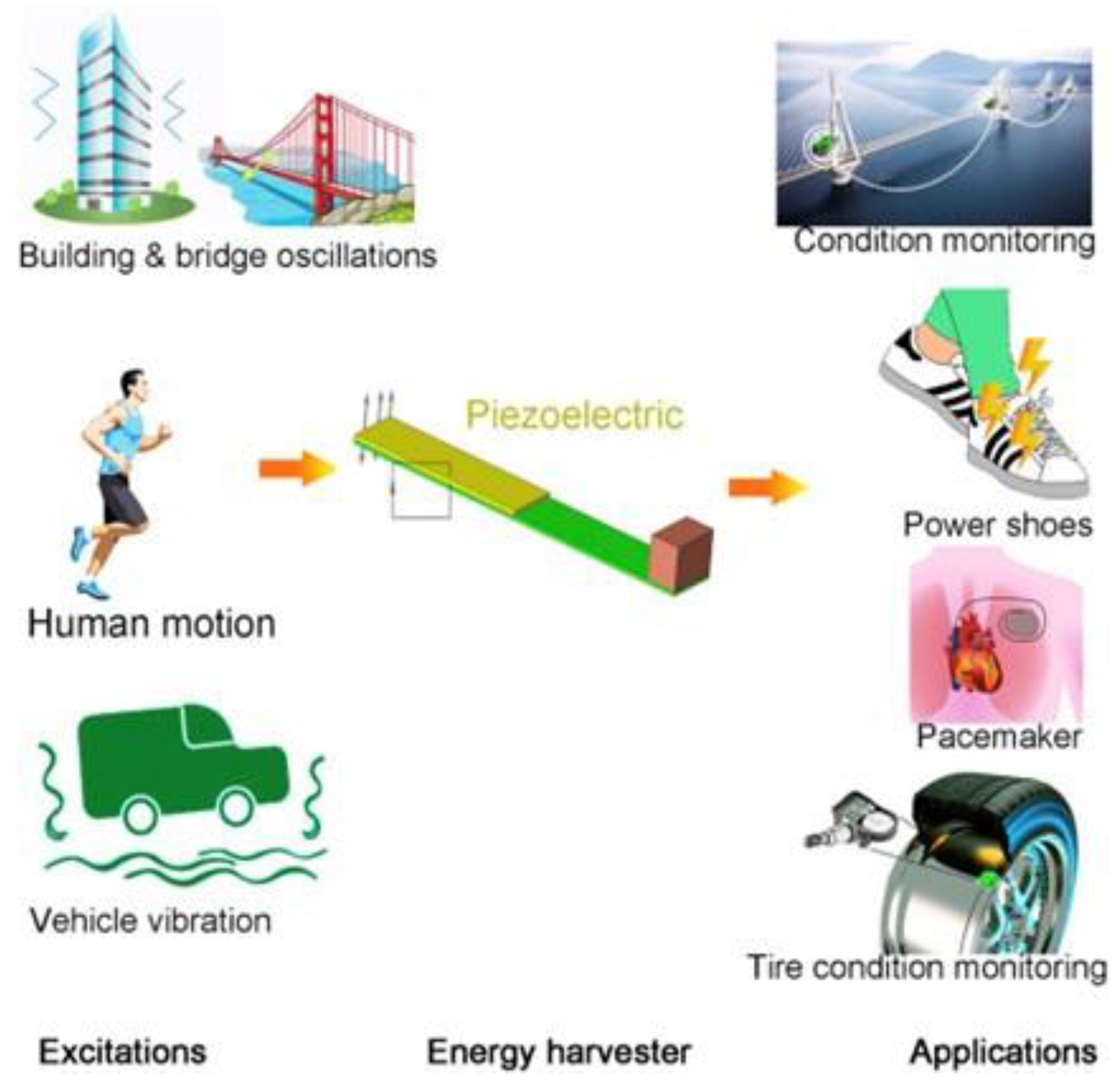
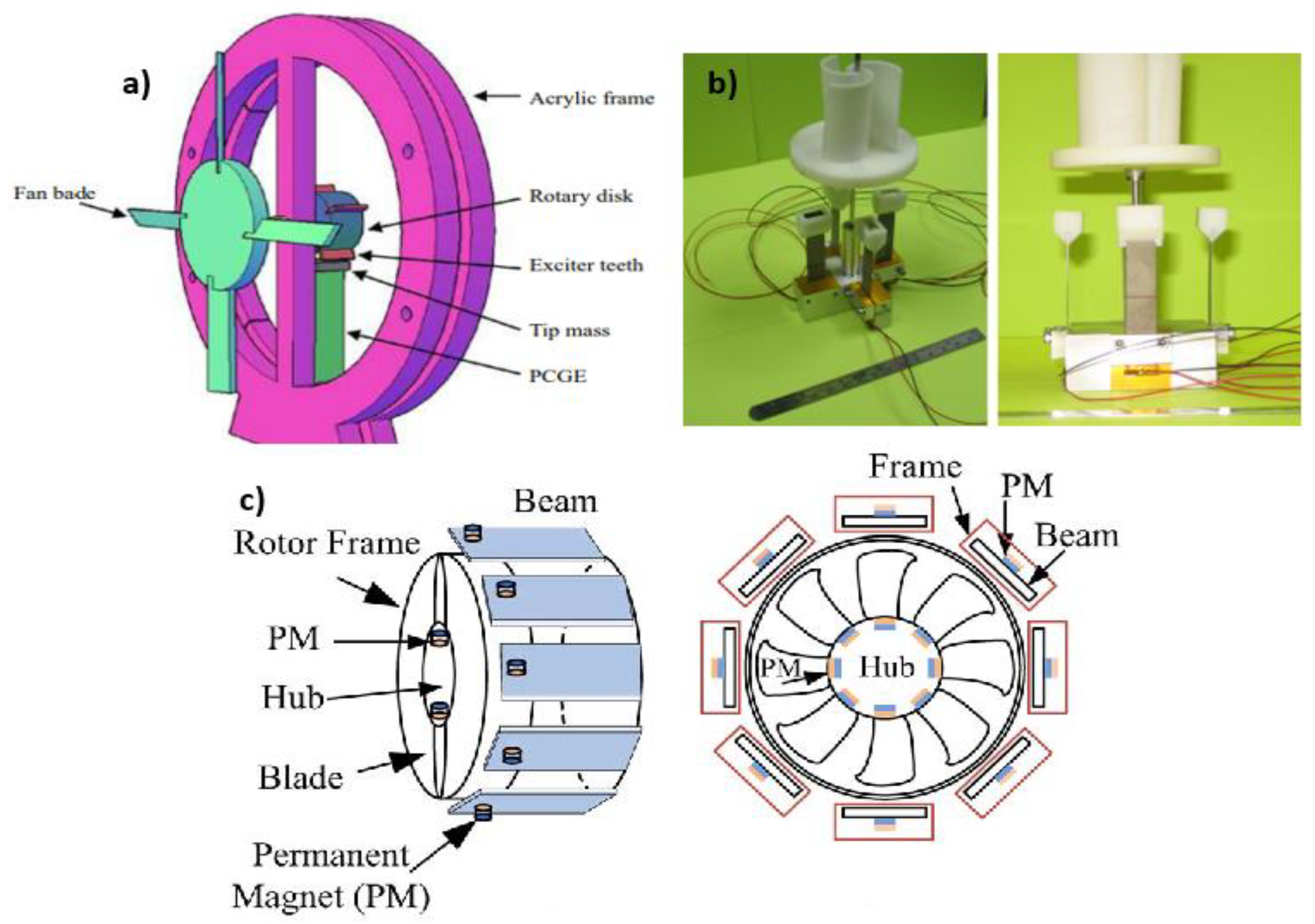
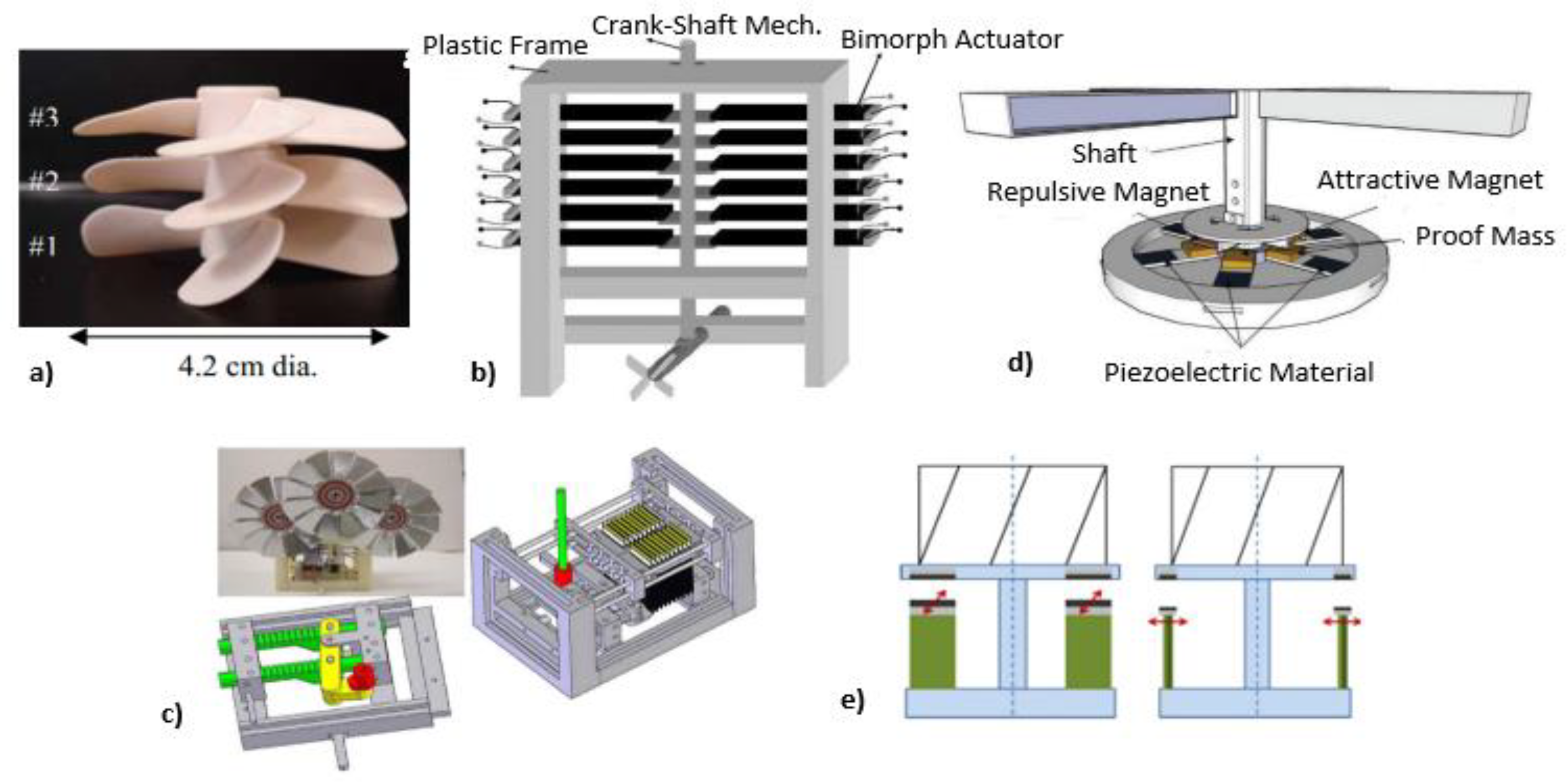
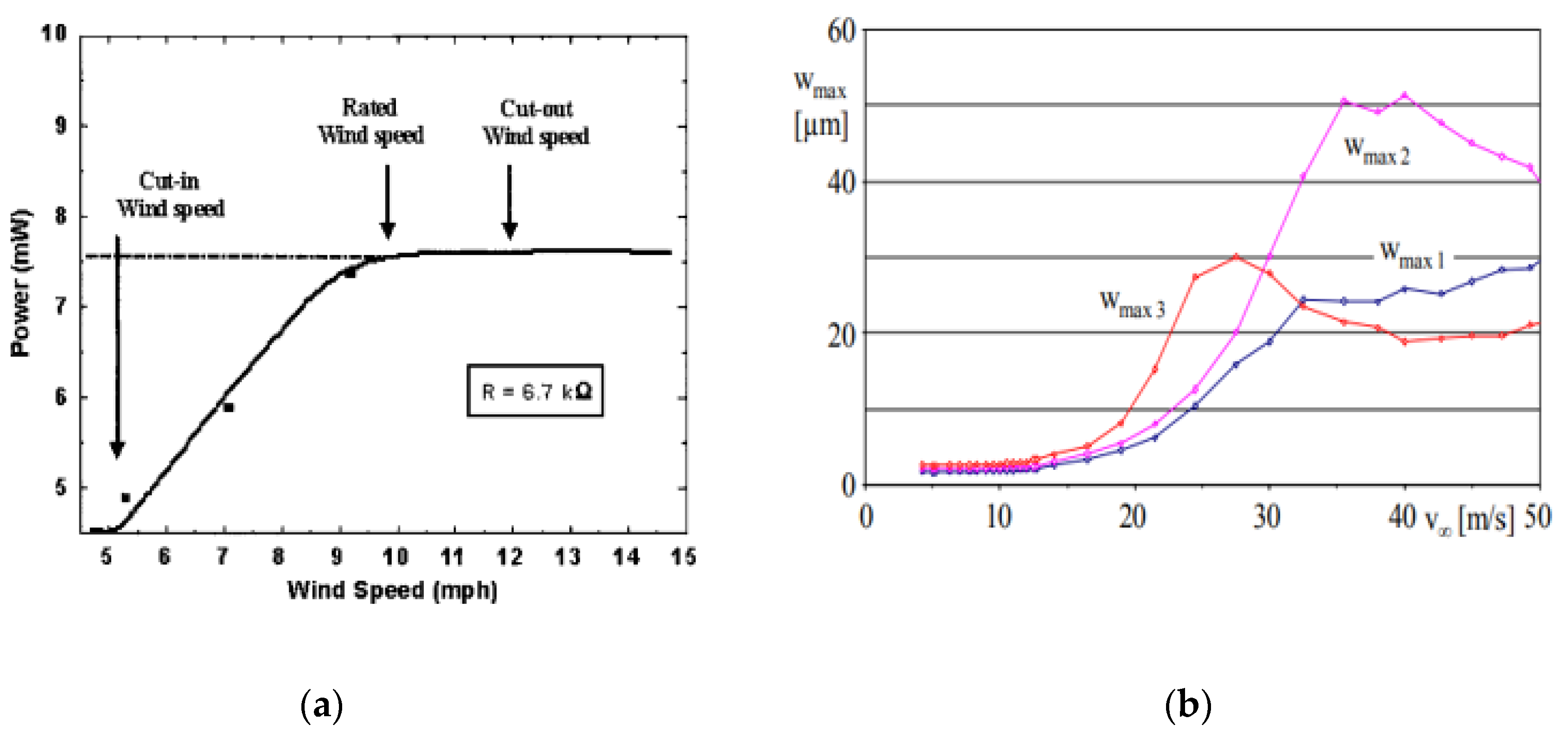
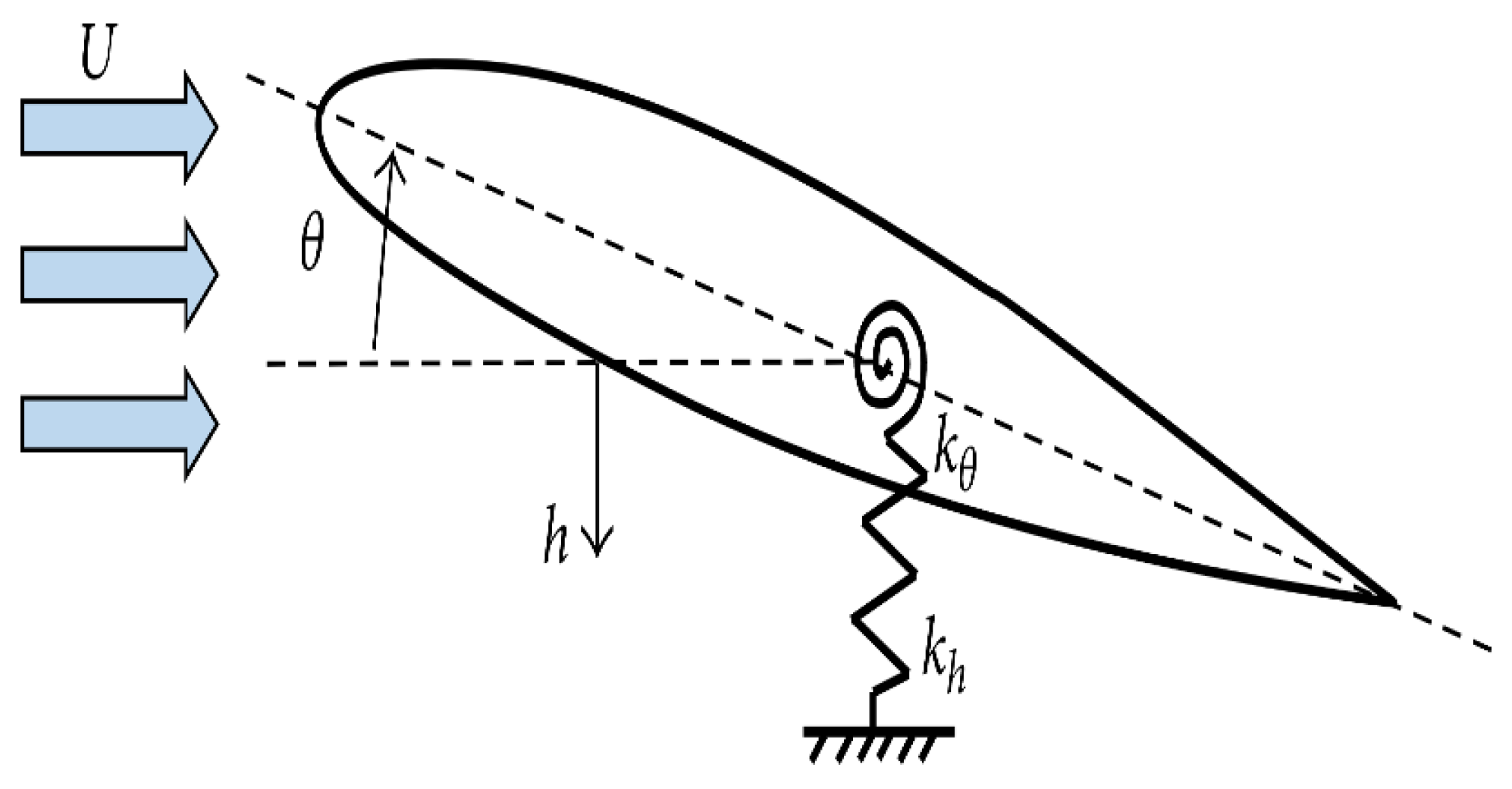
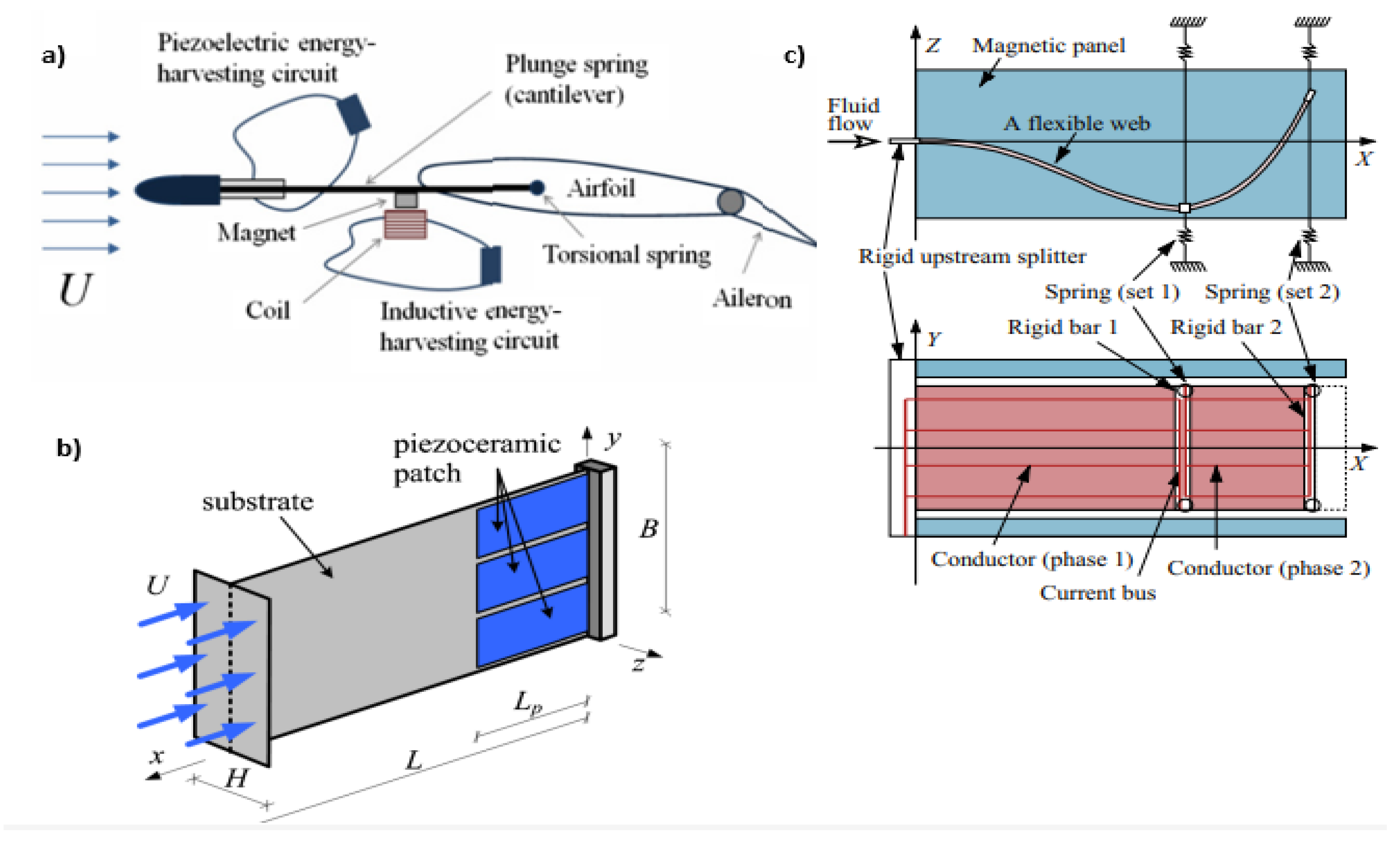
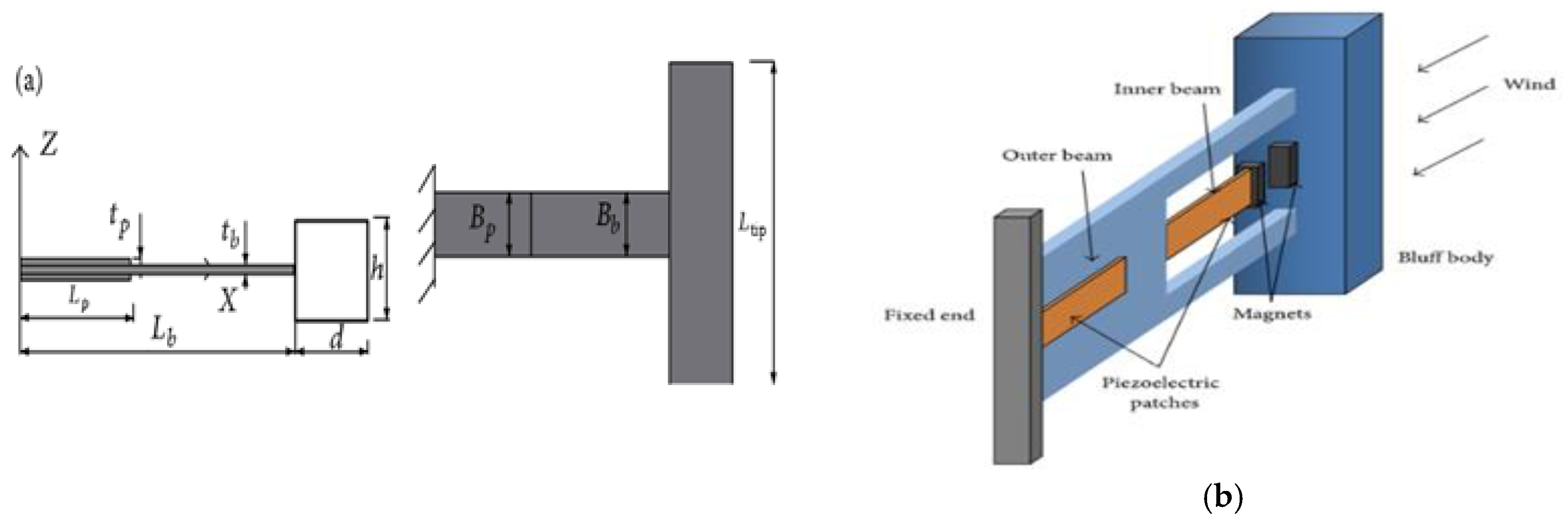

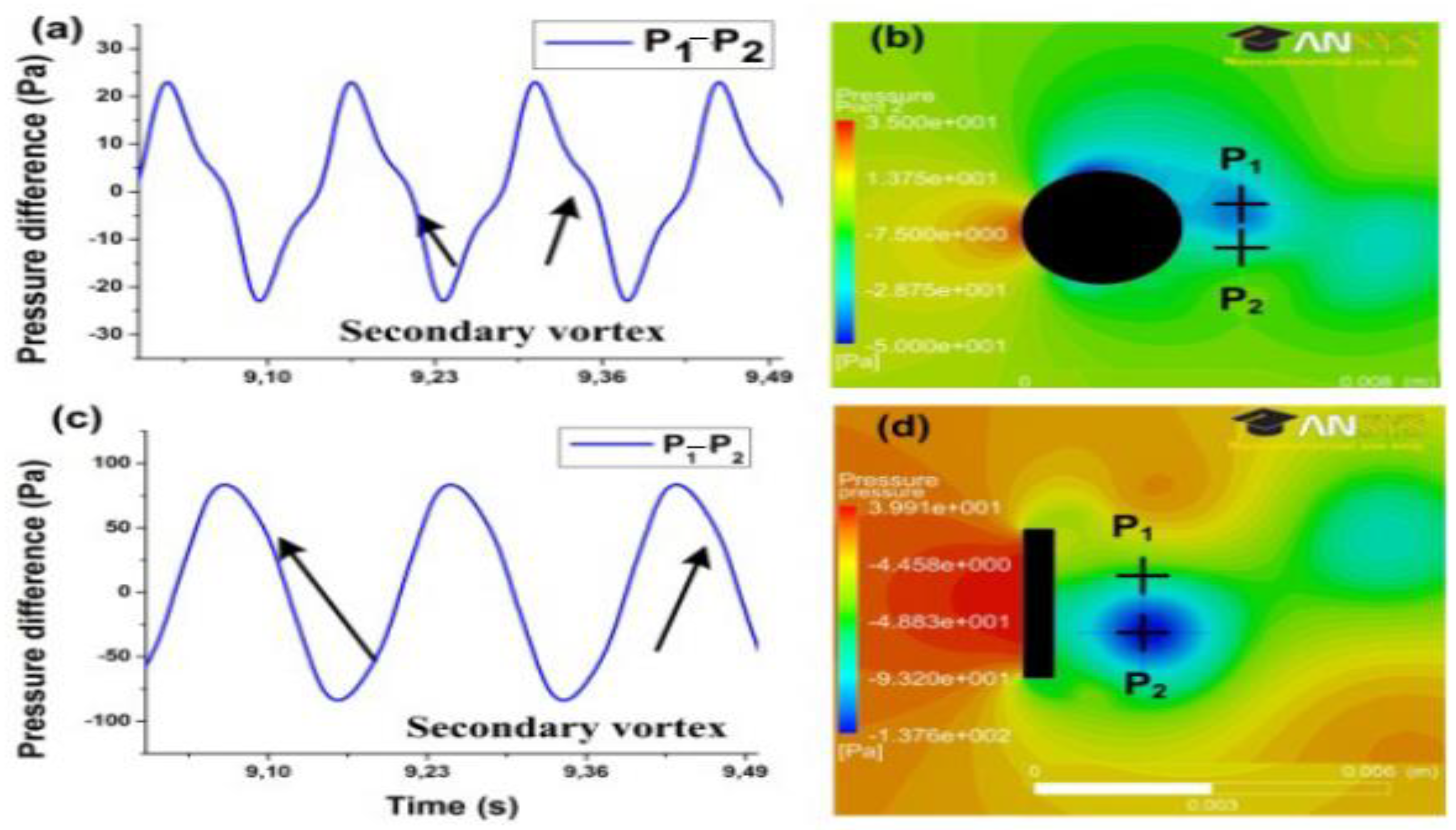
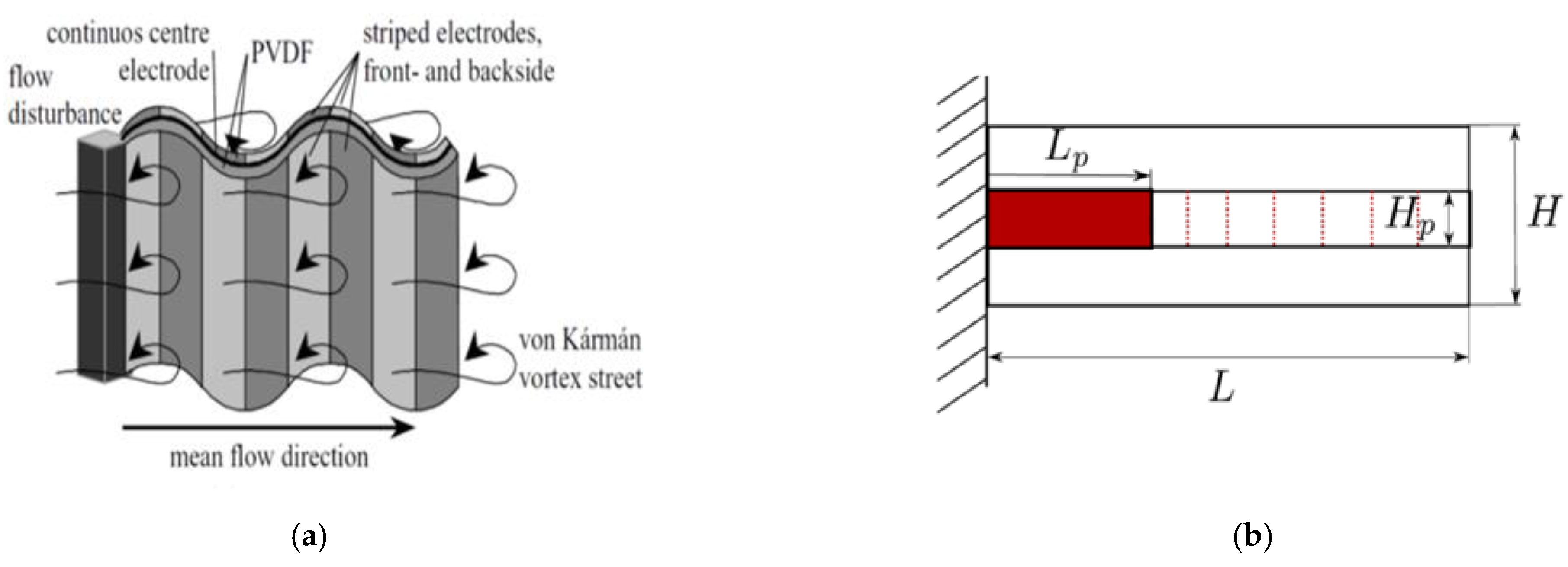
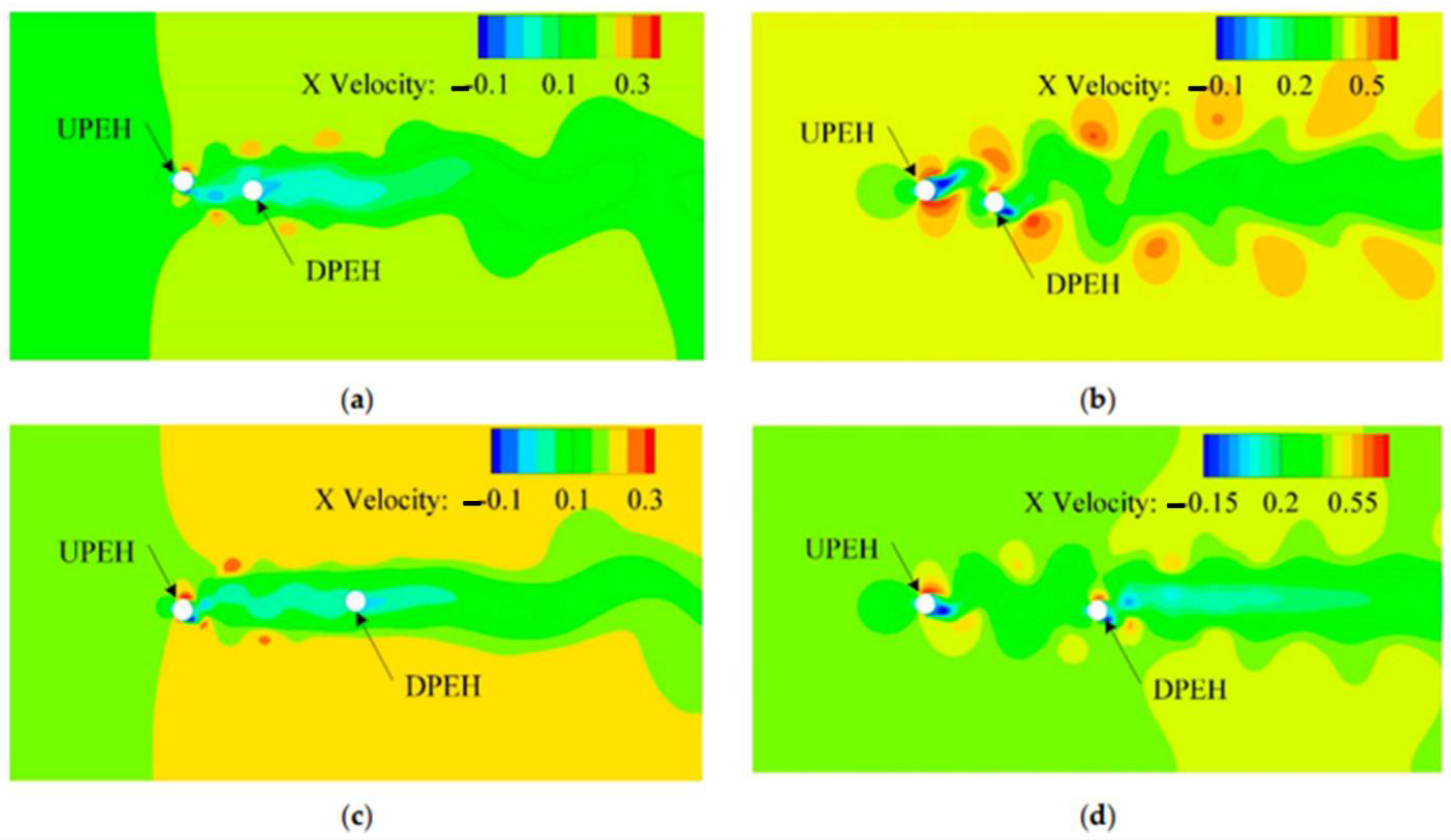
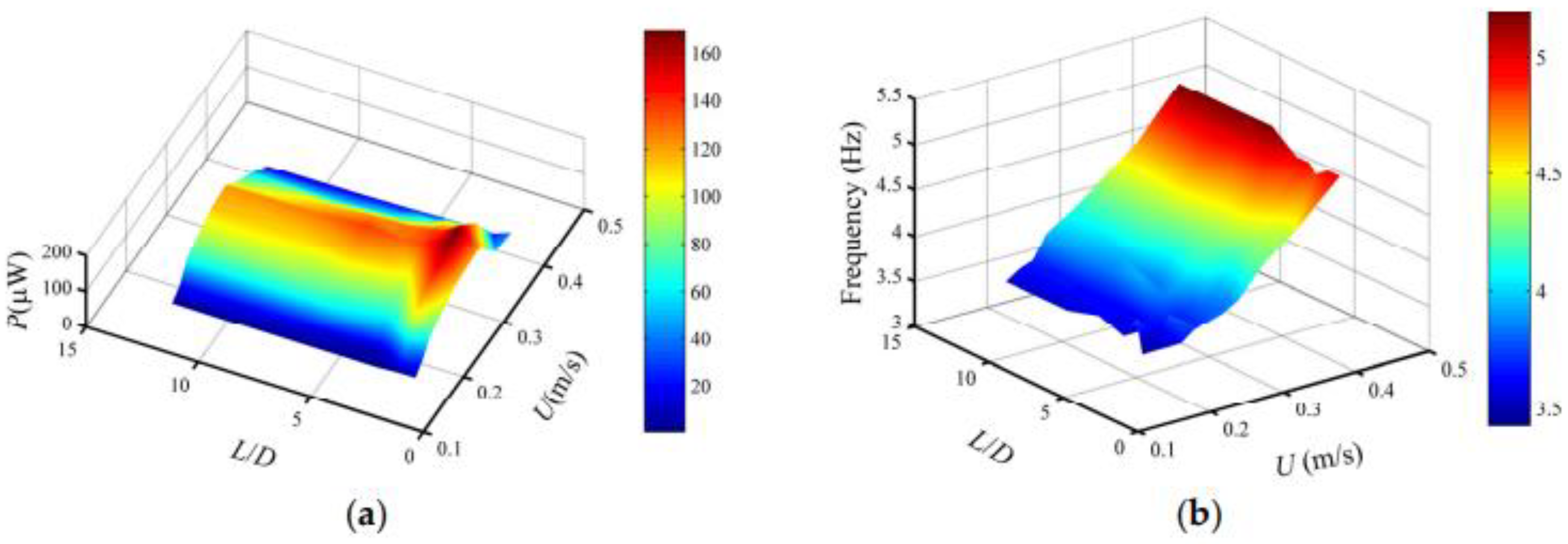
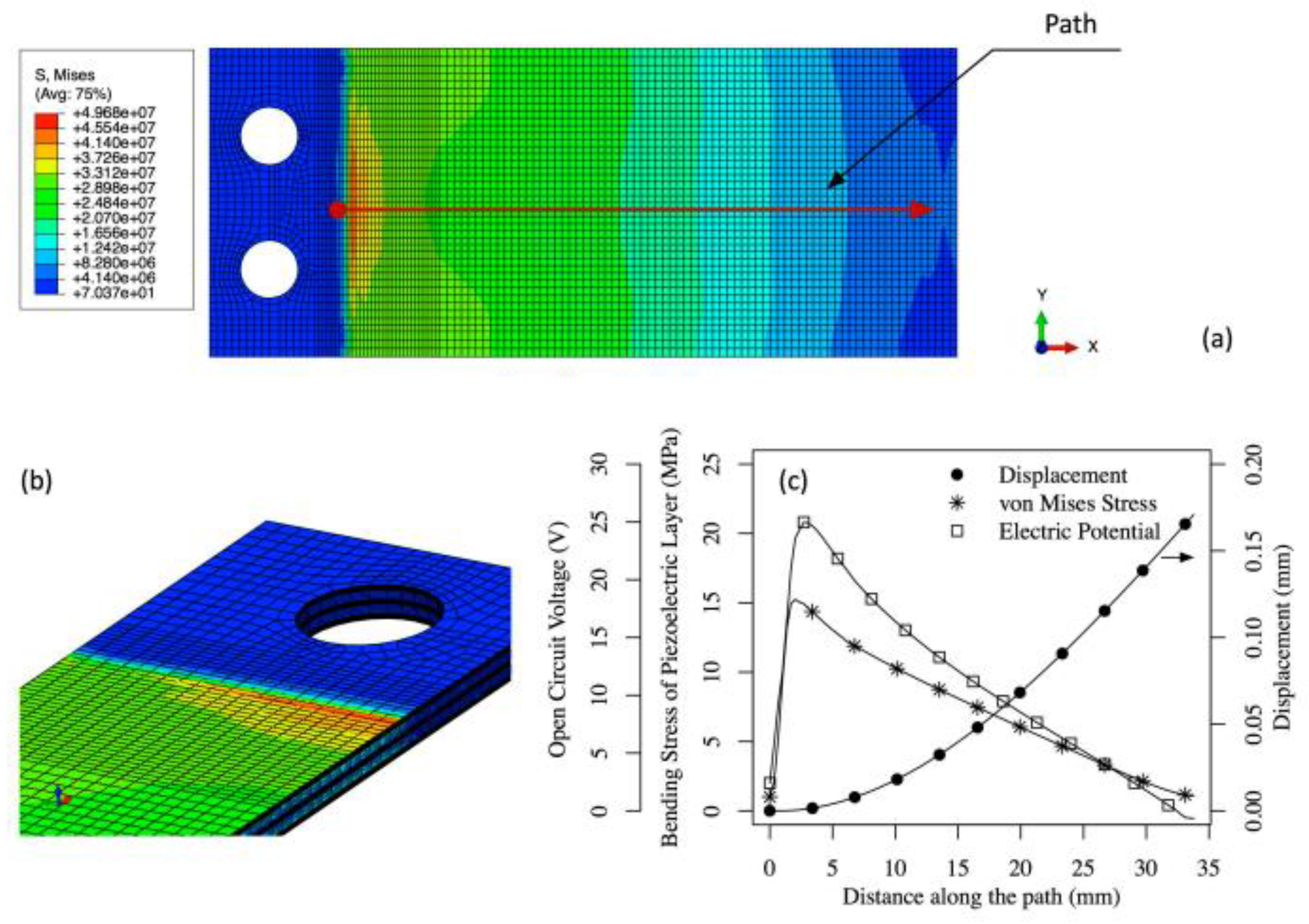
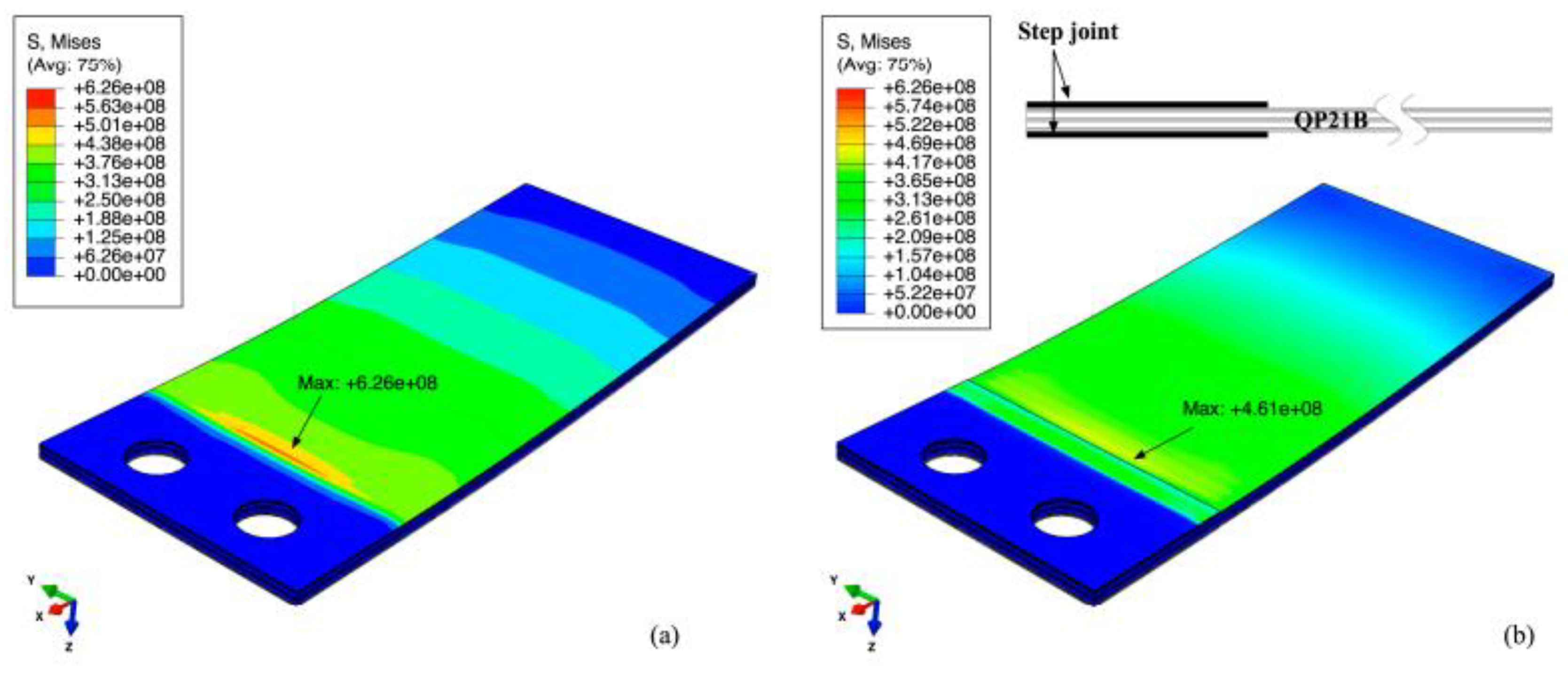

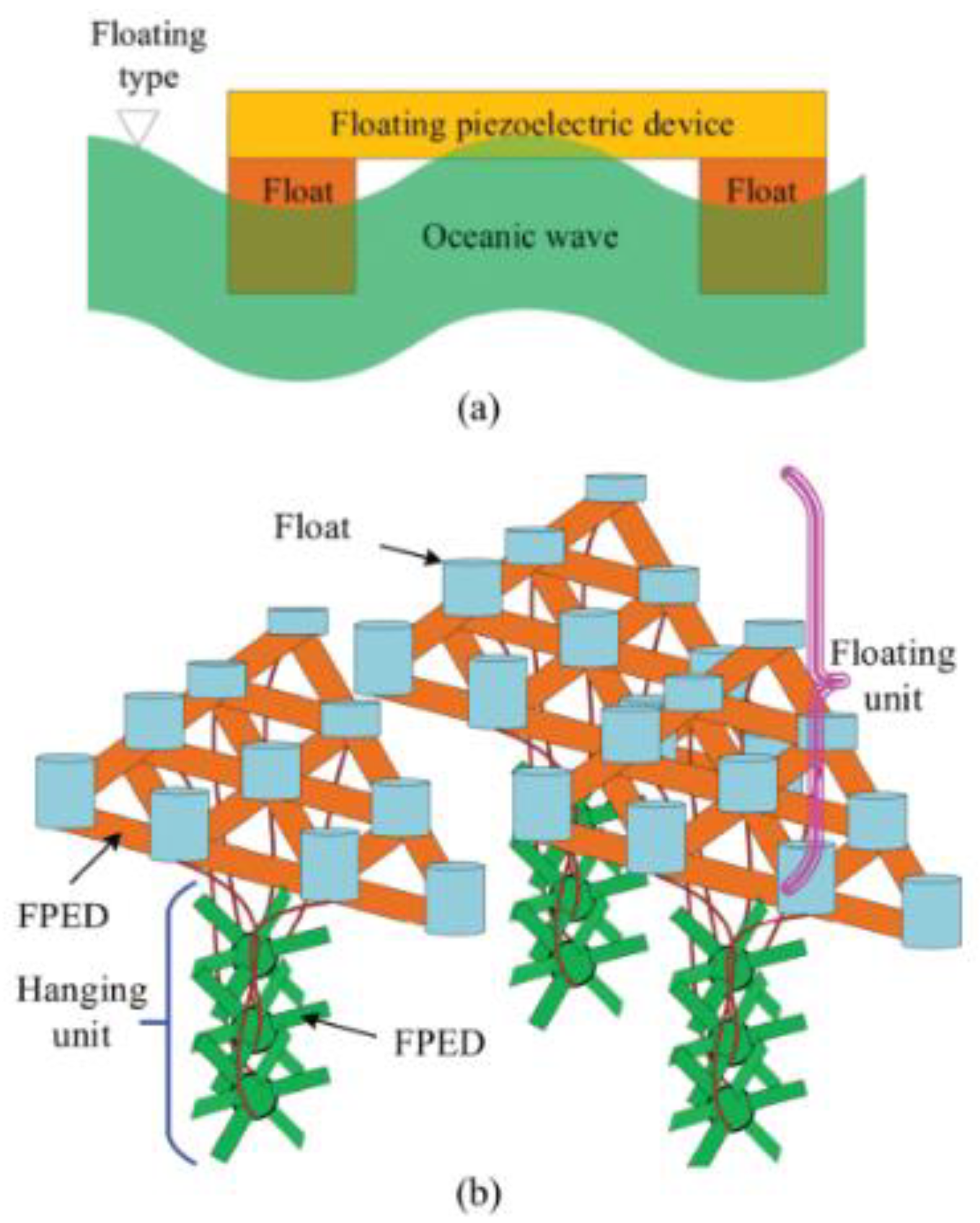
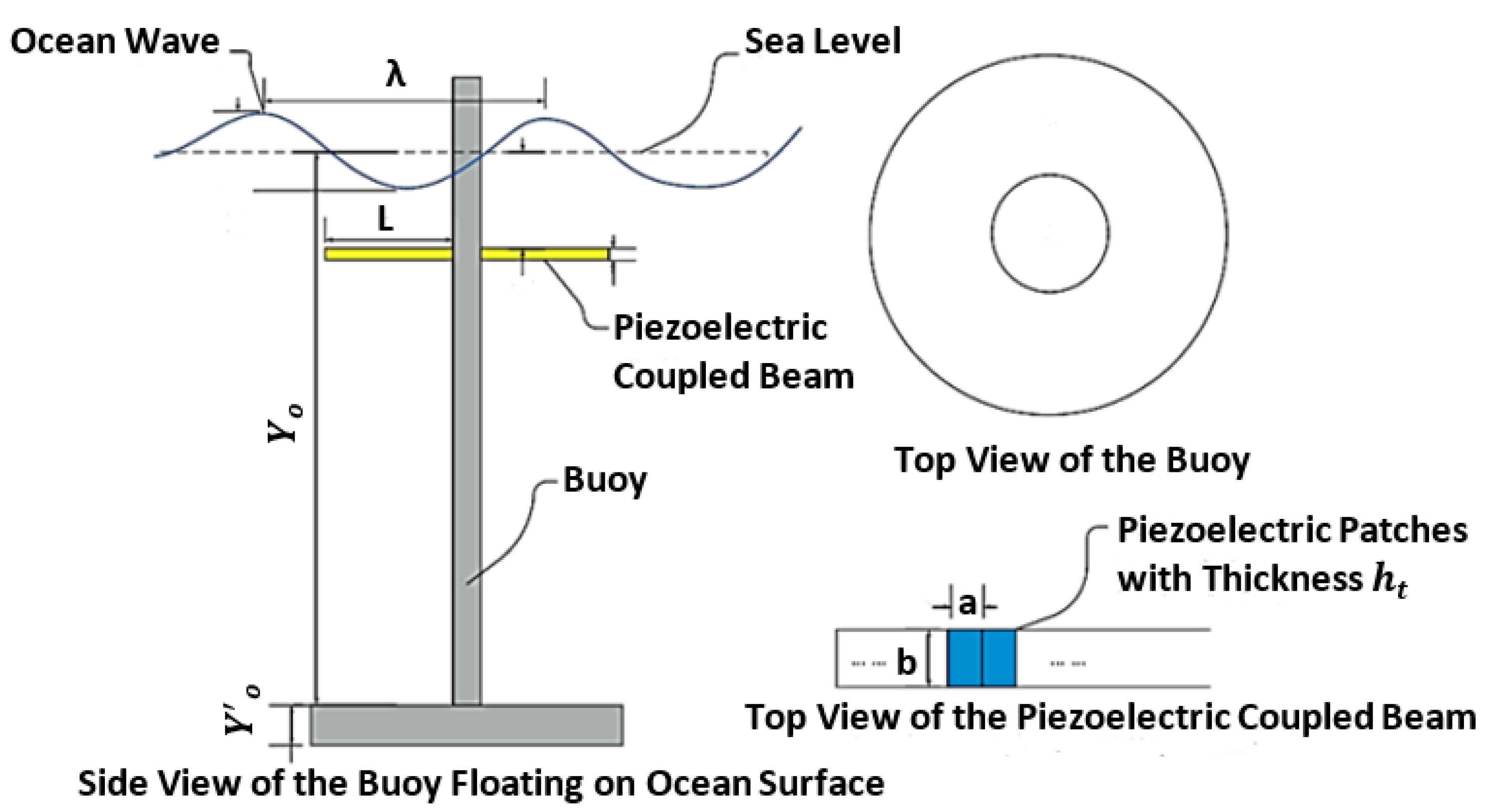
| Windmill and Wind Turbine Energy Harvesting Devices | |||||||||
| Sr No. | Device | Transducer Type | Dimensions | Cut-In Wind Speed (m/s) | Cut-Out Wind Speed (m/s) | Wind Speed (m/s) | Relevant Information | References | |
| 1. | Fan-type windmill | Piezoelectric bimorph | 0.01042 | each beam | - | - | 4.47 | - | [134] |
| 2. | Vane-type vertical windmill | Piezoelectric bimorph | 7.38 × 10−6 | 96 × 107 × 66 mm3 generator, 178 mm vane diameter | - | - | 4.47 | - | [135] |
| 3. | Fan-type windmill | Piezomagnetic generator PZT-5A | - | 31 mm diameter | 0.9 | - | 0.9 | - | [136] |
| 4. | Fan-type windmill using impact-induced resonance | Piezoelectric unimorph PZT ceramic | - | 31 mm diameter | - | - | Not specified (fan with the speed of 200 RPM rotation) | - | [137] |
| 5. | Contactless windmill, Savonius turbine | Piezomagnetic generator | 1.9 × 10−7 | - | - | 4.02 |
| [137] | |
| 6. | Small-scale windmill and turbine | Piezoelectric material. Contact via mechanical stopper | 0.00267 | 2.1 | 6.2 | 5.4 | [138] | ||
| Flutter Energy Harvesting Devices in Wind Flow | |||||||||
| Sr No. | Device | Transducer Type | ) | Wind Speed (m/s) | Cut-In Wind Speed (Flutter speed) (m/s) | Cut-Out Wind Speed (m/s) | Dimensions | Relative Information | References |
| 1. | Rigid flap with revolute joint | Bimorph_ PZT | 6.3 × 10−5 | 7.9 | 2.6 | - | - | [138] | |
| 2. | The piezoelectric film with plastic extension | Rectangular film PVDF | 2 | - | - | - | [138] | ||
| 3. | Piezoelectric grass | Bimorph | 0.0038 | 11.5 | - | - | beams | - | [139] |
| 4. | Inverted flag | Piezoelectric membrane | 0.00347 | 9 | - | - | - | [139] | |
| 5. | Modal convergence flutter with flat plate | Piezoelectric | Stiff host: 6.078 Compliant host: 4.696 | Stiff host: 26 Compliant host: 25 | Stiff host: 17.3 Compliant host: 15.2 | Stiff host: 29 Compliant host: 29 | Flat plate tip: span 6 cm, chord 3 cm, thickness 0.79 mm. |
| [139] |
| 6. | Dual cantilever flutter | Piezoelectric | 0.845 | 13 approx. | 3 approx. | - | Efficient power generation with high operational wind speed | [140] | |
| Micro Scale Piezoelectric Wind Energy Harvesters | |||||||||
| Sr No. | Transducer | Mechanical Mechanism | Size (mm) | Peak Power | Voltage | Wind Speed(m/s) | Power Coefficient Cp (%) | Normalized Power Density (μW × s/ (mm3 × m)) | References |
| 1. | Piezoelectric | Aeroelastic | 2 × 1.65 × 0.005 | 34 nW | 25 mW | 5.2 | 0.012 | 0.39 | [140] |
| 2. | Piezoelectric | Rotational | 47 × 20 × 0.5 | 613 µW | 13 V | 200 r/min | - | - | [141] |
| 3. | Piezoelectric | Aeroelastic | 75 × 20 × 0.004 | 0.98 µW | 1.2 V | 3.9 | 0.002 | 0.041 | [141] |
| 4. | Piezoelectric | Rotational | ϕ = 53 | 7.5 mW | 5 V | 4.47 | 6.32 | - | [142] |
| 5. | Piezoelectric | Aeroelastic | 23 × 4 × 0.130 | 0.64 µW | 1.6 V | 15 | 0.004 | [143] | |
| 6. | Piezoelectric | Aeroelastic | 58 × 10 × 0.202 | 30 µW | 4.3 V | 5 | 0.06 | 0.05 | [144] |
| 7. | Piezoelectric | Aeroelastic | 3 × 8 × 0.035 | 2.27 µW | 965 mV | 16.3 | 0.004 | 0.17 | [144] |
| 8. | Piezoelectric | Aeroelastic | 69 × 37 × 0.24 | 3.3 V | 1 mW | 2 | 8.1 | 0.81 | [145] |
| Macro Scale Piezoelectric Wind Energy Harvesters | |||||||||
| Sr No. | Transducer | Mechanical Mechanism | Size (mm) | Voltage | Power Peak | Wind Speed(m/s) | Power Co-efficient Cp (%) | Normalized Power Density (μW × s/ (mm3 × m)) | References |
| 1. | Piezoelectric | Aeroelastic | 76.7 × 12.7 × 2.2 | 8.8 V | 155 µW | 6.7 | 0.09 | 0.01 | [145] |
| 2. | Piezoelectric | Rotational | ϕ = 80, t = 170 | 80 mV | 2 µW | 14 | [146] | ||
| 3. | PZ | Aeroelastic | 90 × 10 × 0.6 | 12 V | 145 µW | 3.5 | 0.63 | 0.08 | [147] |
| 4. | PZ | Rotational | 325 × 36.2 × 0.267 | 30 V | 1.14 mW | 4.96 | 0.15 | 0.077 | [148] |
| Ref. | Technique | Brief Title | Highlights | Authors |
|---|---|---|---|---|
| [149] | VIV | Flow-induced based on PEH | Utilizing a one-dimensional approach to investigate the function of an adaptable piezoelectric cylinder, the produced power | Xie et al. |
| [150] | VIV | Tree-simulated piezoelectric | Four cylindrical linear arrays connected to piezoelectric actuator were tested in the wind. | Hobbs and Hu. |
| [151] | VIV | Designing of fluid K.E harvesters | The harvester was optimized using a cuboid-shaped bluff body and a 1 μ W output power. | Wen et al. |
| [151] | VIV | Air conditioners containing piezoelectric | A piezoelectric energy-harvesting system was offered based on VIV with a fin for use in turbulent airflow. | Weinstein et al. |
| [151] | VIV | Cylindrical extension on piezoelectric cantilevers | A wind-driven cylinder with a piezoelectric beam attached to the edge has been described as an energy harvester. | Gao et al. |
| [151] | VIV | Piezoelectric analysis with non-uniformity | Investigating a piezoelectric cantilever ray connected to the radial cylinder subjected to nonuniform distribution structure. | Dai et al. |
| [152] | VIV | Fluidic energy with flexible beam | By the usage of flexible beam piezoelectric harvesting vibrational energy construct of VIV. | Dunnmon et al. |
| [152] | VIV | Circular cylinder of VIV | Enhancing the efficiency of dual-mass development compromises on a circular cylinder. | Dunnmon et al. |
| [152] | Flapping | Oscillations in the aeroelastic limit cycle | In a wind s velocity of 27 m.s-1, piezoelectric plates were put on a floppy sheet. | Dunnmon et al. |
| [153] | Flapping | Cross flow fluttering by the usage of wind harvesters | Wind energy was turned into electrical energy by a swinging leaf dependent on aeroelastic fluttering. | Li et al. |
| [154] | TIV | TIV comprising of artificial piezoelectric grass | TIV was studied using a piezoelectric grass and a variable structure model. | Hobeck and Inman |
| [154] | TIV | TIV with a mathematical framework | TIV force of a unimorph cantilever was given by scattered a computational model. | Hobeck and Inman |
| [155] | TIV | Micromachined piezoelectric harvesting | 2W of energy is produced by a MEMS piezoelectric and a Helmholtz oscillator that includes a packed harvester. | Matova et al. |
| [156] | TIV | Unsteady flows for piezoelectric | Flexible piezoelectric cantilever beams were positioned in turbulent boundary layers to generate 0.06 W. | Akaydin et al. |
| [156] | TIV | Wake of a cylinder | Applying piezoelectric beams, the greater Reynolds values were used to study the effects of radial cylinders. | Akaydin et al. |
| [157] | TIV | Turbulent boundary layers in piezoelectric transducers | In a turbulent boundary layer, several piezoelectric beams were examined. | Goushcha |
| [158] | FIV | In axial flows, the performance of piezoelectric flags | A nonlinear variant of the FIV was proposed for a moving plate in an axial flow using piezoelectric patches. | Michelin and Doare. |
| [159] | FIV | Piezoelectric cantilever of T-shaped | Depending on the aeroelastic oscillation, a T-shaped piezoelectric cantilever was demonstrated. | Kwo |
| [160,161] | FIV | Single piezoelectric generator of aerodynamic | A piezo-aeroelastic energy harvesting system that depends on flutter was studied. | Bibo and Daqaq. |
| [162] | FIV | Aeroelasticity nonlinearity | Piezoelectric transmission and airfoil form nonlinear investigation methods. | Dowell et al. |
| [163] | FIV | Piezoaeroelastics analysis | To prevent pressurized collapse of piezo-aeroelastic harvesters, a nonlinear model was investigated. | Abdelkefi et al. |
| [164] | Galloping | Low-power sensors containing wind harvesters | In an air velocity of 11.6 miles per hour, a galloping-based piezoelectric yielded a captured energy of moreover 50 mW. | Sirohi and Mahadi. |
| Devices | Types of Transducers | Generator Material | Dimensions | Flow Characteristics | Output Power | Energy Source | Reference |
|---|---|---|---|---|---|---|---|
| Piezoelectric-buoy harvester | Two-stage buoy mechanism | PDVF | 76.2 × 76.2 × 914.4 mm3 | - | 60–180 mW | Ocean Waves | [186] |
| Energy harvesting | Bimorph | PVDF | 240 × 76 × 0.150 mm3 | 0.5 m/s flow | 3 W | - | [186] |
| Transverse wave harvester | Horizontal bimorph | PVD-4 | 2 cantilevers of 2.4 × 1 × 0.01 m3 | - | 30 W RMS | Transverse ocean waves | [187] |
| Fluttering flag | Bimorph | PZT | 14 × 11.8 × 10.35 mm3 | 45 m/s flow | 0.1 mW | - | [187] |
| Rain harvester | Unimorph | PVDF | 25 × 13 × 3 mm3 | - | 2.5 nW | Rain Drops | [188] |
| Fluid fluctuation harvester with PVDF | Diaphragm | PVDF | 25 × 13 × 0.150 mm3 | 1.196 kPa pressure fluctuation at 26 Hz | 0.2 µW | - | [189] |
| Harvester with deep ocean wave | Bimorph-buoy | PZT-4 | 2 cantilevers of 1 × 0.2 × 0.006 m3 | - | 24 W RMS | Transverse ocean waves | [189] |
| Fluid fluctuation harvester with PZT | Diaphragm | PZT | 8 × 3 × 0.200 mm3 | 20.8 kPa pressure fluctuation at 45 Hz | 0.45 nW | - | [190] |
| Hydraulic harvester | Stack | PZT | 6.8 × 6.8 × 30 mm3 | - | 1.2 mW | Hydraulic pressure | [191] |
| Longitudinal wave harvester | Vertical bimorph | PZT-4 | 3 × 1 × 0.05 m3 | - | 55 W RMS | Longitudinal ocean waves | [192] |
| Tubular energy harvester | Tube | PZT-5A | 8 mm inner radius, 2 mm thickness, 20 mm length | - | 0.1 W | Pressure inside tubes | [192] |
| Energy harvesting | Cymbal transducer | PMN-PT | 25 × 5 × 1 mm3 | - | 3.7 mW | - | [193] |
| Energy harvesting | Unimorph | PMN-PZT | 20 × 5 × 0.5 mm3 | - | 0.015 mW | - | [194] |
| Energy harvesting | Beam | PMN-PT | 7.4 × 2 × 0.1 mm3 | - | 7.18 µW | - | [195] |
| Cantilever leaf structure | - | Microfiber composite (MFC) piezoelectric | 2.8 × 1.4 × 0.03 mm3 | 7.5 m/s flow | 0.55 mW | - | [196] |
| Nested structure by piezoelectric galloping | Beam | M2814P2 (MFC) | 180 × 10 × 0.8 mm3 | 2.1 m/s flow | 0.16 mW | Wind | [197] |
| Technique | Brief Title | Highlights | Authors |
|---|---|---|---|
| Eel | Eel-based harvesting | The initial study used an eel technique to create a flexible PVDF membrane (2001). | Taylor et al., Allen and Smits |
| VIV | Bicylinder having MFC piezoelectric cantilever | A bicylinder VIV piezoelectric harvester generated 21.86 W of power in water flow. | Song et al. |
| VIV | Using PZT producing VIV from water | The output power of a vertical cylinder harvester experiencing VIV from water flow was 84.49 W. | Song et al. |
| VIV | Vibrational energy with piezoelectric transducers | Piezoelectric transducers gathered energy from a tiny network’s fluid flow (2016). | Hassan et al. |
| Micropump | Non-valve nozzle | A pioneering piezoelectric mini pump with no valve was investigated (1993). | Stemme |
| Micropump | Piezoelectric pump without valves | A piezoelectric pump having a dynamic model was proposed (2001). | Ullmann et al. |
| Micropump | A dynamic model for pump without valves | A piezoelectric non-valve pump’s efficiency was improved (2002). | Ullmann |
| Micropump | Ring-type actuators in micropumps with valves | Simulation of piezoelectric valveless systems is rather comprehensive, so a micro-pump was used (2006). | Zhang and Wang |
| Micropump | Micropump having a circular actuator | For a circular piezoelectric micro-pump operator, the FE approach was examined (2000). | Morris and Forster |
| Micropump | Micropump diaphragm containing polymer | A PVDF-TrFE microfluidic pump was studied (2005). | Xu and Su |
| Micropump | Microfluidic electroactive pump | A PVDF-TrFE micro-pump with an actuator was investigated (2006). | Xia et al. |
| Micropump | Printed piezoelectric inkjet | For PVDF-constructed transducers, an all-inkjet-printed piezoelectric polymer method was developed (2013). | Pabst et al. |
| VIV | Water vortex containing MFC piezoelectric | Yielded 1.32 watts of power by water-induced vibration utilizing an MFC piezoelectric. | Shan et al. |
| Eel | Axial flow cantilevered bendable panels | Flutter-mill analytical modeling was used to harvest fluid flow’s electrical energy (2009). | Tang et al. |
| VIV | Water way with microscale piezoelectric | The extremity of a bluff body was fitted with a flexible piezo-film transducer. | Koyvanich et al. |
| Energy Source | Harvesting Strategy | Material | Coupling Mode |
|---|---|---|---|
| Water Current | Flow-induced vibration | PVDF | 3-1 mode |
| Wave Motion | Tilting and heaving of bodies | PZT | 3-3 mode |
| Bodies anchored to the ocean bed | PVDF/PZT | 3-1 mode | |
| Ocean surfaces with adjustable membrane | PVDF | 3-1 mode | |
| Resultant Forces of Waves | Splashing | PVDF | 3-3 mode |
| Ref. | Short Topics | Illustration | Authors |
|---|---|---|---|
| - | Piezoelectric windmill simulation | The piezoelectric windmill pattern used the frequency up-conversion technique (2005). | Priya |
| [211] | Oceanic wave-energy transducers | The frequency up-conversion approach was used to construct WEC system piezoelectric vibrators (2011). | Zhang and Lin |
| [212] | In the converters for ocean-wave energy | Low-cost disc piezoelectric components have been used in the WEC device (2013). | Vinolo et al. |
| [213] | Conversion of ocean-wave energy | A line of piezoelectric micro-thin sheets was used in a wave-power harvester (1987). | Burns |
| [214] | Harvesting energy from transverse ocean waves | Connected to the piezoelectric marks is a cantilever (2014). | Xie et al. |
| [214] | The piezoelectric potential for marine waves | A vertical cantilever column was installed on the seabed with piezoelectric patches attached (2014). | Xie et al. |
| [215] | Oceanic wave-energy harvesting | A cost-effective solution for oceanic piezoelectric wave-energy harnessing was given (2015). | Wu et al. |
Publisher’s Note: MDPI stays neutral with regard to jurisdictional claims in published maps and institutional affiliations. |
© 2022 by the authors. Licensee MDPI, Basel, Switzerland. This article is an open access article distributed under the terms and conditions of the Creative Commons Attribution (CC BY) license (https://creativecommons.org/licenses/by/4.0/).
Share and Cite
Naqvi, A.; Ali, A.; Altabey, W.A.; Kouritem, S.A. Energy Harvesting from Fluid Flow Using Piezoelectric Materials: A Review. Energies 2022, 15, 7424. https://doi.org/10.3390/en15197424
Naqvi A, Ali A, Altabey WA, Kouritem SA. Energy Harvesting from Fluid Flow Using Piezoelectric Materials: A Review. Energies. 2022; 15(19):7424. https://doi.org/10.3390/en15197424
Chicago/Turabian StyleNaqvi, Areeba, Ahsan Ali, Wael A. Altabey, and Sallam A. Kouritem. 2022. "Energy Harvesting from Fluid Flow Using Piezoelectric Materials: A Review" Energies 15, no. 19: 7424. https://doi.org/10.3390/en15197424
APA StyleNaqvi, A., Ali, A., Altabey, W. A., & Kouritem, S. A. (2022). Energy Harvesting from Fluid Flow Using Piezoelectric Materials: A Review. Energies, 15(19), 7424. https://doi.org/10.3390/en15197424








